Democratic Party (United States)
The Democratic Party is one of the two major contemporary political parties in the United States, along with its main rival, the Republican Party. Tracing its heritage back to Thomas Jefferson and James Madison's Democratic-Republican Party, the modern-day Democratic Party was founded around 1828 by supporters of Andrew Jackson, making it the world's oldest active political party.[12]
Before 1860, the party supported limited government and state sovereignty while opposing a national bank and high tariffs. In the late 19th century, it continued to oppose high tariffs and had bitter internal debates on the gold standard. In the early 20th century, it supported progressive reforms and opposed imperialism. Since Franklin D. Roosevelt and his New Deal coalition in the 1930s, the Democratic Party has promoted a social liberal platform.[3][13] Well into the 20th century, the party had conservative pro-business and Southern conservative-populist wings; following the New Deal, however, the conservative wing of the party largely withered outside the South. The New Deal coalition of 1932–1964 attracted strong support from voters of recent European extraction—many of whom were Catholics based in the cities.[14][15][16] After the Civil Rights Act of 1964 and the Voting Rights Act of 1965, the core bases of the two parties shifted, with the Southern states becoming more reliably Republican in presidential politics and the Northeastern states becoming more reliably Democratic. The once-powerful labor union element became smaller after the 1970s, although the working class remains an important component of the Democratic base. People living in urban areas, women, college graduates, and millennials, as well as sexual, religious, and racial minorities, also tend to support the Democratic Party.[17][18][19]
The Democratic Party's philosophy of modern liberalism blends notions of civil liberty and social equality with support for a mixed economy.[20] In Congress, the party has influential centrist, progressive, and conservative wings. Corporate governance reform, environmental protection, support for organized labor, maintenance and expansion of social programs, affordable college tuition, universal health care, equal opportunity, and consumer protection form the core of the party's economic agenda.[21][22] On social issues, it advocates campaign finance reform,[23] LGBT rights,[24] criminal justice and immigration reform,[25] stricter gun laws,[26] abortion rights,[27] and the legalization of marijuana.[28]
15 Democrats have served as President of the United States. The first was Andrew Jackson, who was the seventh president and served from 1829 to 1837. The most recent was Barack Obama, who was the 44th and held office from 2009 to 2017. As of 2020, the Democrats hold a majority in the House of Representatives, 15 state government trifectas (governorship and both legislative chambers),[29] the mayoralty of most major American cities,[30] and 19 total state legislatures. Four of the nine sitting justices of the Supreme Court were appointed by Democratic presidents.
History
.jpg)
Democratic Party officials often trace its origins to the inspiration of the Democratic-Republican Party, founded by Thomas Jefferson, James Madison and other influential opponents of the Federalists in 1792. That party also inspired the Whigs and modern Republicans. Organizationally, the modern Democratic Party truly arose in the 1830s with the election of Andrew Jackson. Since the nomination of William Jennings Bryan in 1896, the party has generally positioned itself to the left of the Republican Party on economic issues. Democrats have been more liberal on civil rights since 1948, although conservative factions which opposed them persisted in the South until the 1960s. On foreign policy, both parties have changed position several times.[31]
Background
The Democratic Party evolved from the Jeffersonian Republican or Democratic-Republican Party organized by Jefferson and Madison in opposition to the Federalist Party. The Democratic-Republican Party favored republicanism; a weak federal government; states' rights; agrarian interests (especially Southern planters); and strict adherence to the Constitution. The party opposed a national bank and Great Britain.[32] After the War of 1812, the Federalists virtually disappeared and the only national political party left was the Democratic-Republicans, which was prone to splinter along regional lines. The era of one-party rule in the United States, known as the Era of Good Feelings, lasted from 1816 until 1828 when Andrew Jackson became president. Jackson and Martin Van Buren worked with allies in each state to form up a new Democratic Party on a national basis. In the 1830s the rivals coalesced into the main rival to the Democrats.
19th century
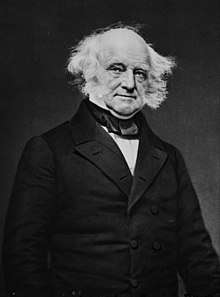
The Democratic-Republican Party split over the choice of a successor to President James Monroe. The faction that supported many of the old Jeffersonian principles, led by Andrew Jackson and Martin Van Buren, became the modern Democratic Party.[33] As Norton explains the transformation in 1828:
Jacksonians believed the people's will had finally prevailed. Through a lavishly financed coalition of state parties, political leaders, and newspaper editors, a popular movement had elected the president. The Democrats became the nation's first well-organized national party [...] and tight party organization became the hallmark of nineteenth-century American politics.[34]
Behind the platforms issued by state and national parties stood a widely shared political outlook that characterized the Democrats:
The Democrats represented a wide range of views but shared a fundamental commitment to the Jeffersonian concept of an agrarian society. They viewed the central government as the enemy of individual liberty. The 1824 "corrupt bargain" had strengthened their suspicion of Washington politics. [...] Jacksonians feared the concentration of economic and political power. They believed that government intervention in the economy benefited special-interest groups and created corporate monopolies that favored the rich. They sought to restore the independence of the individual—the artisan and the ordinary farmer—by ending federal support of banks and corporations and restricting the use of paper currency, which they distrusted. Their definition of the proper role of government tended to be negative, and Jackson's political power was largely expressed in negative acts. He exercised the veto more than all previous presidents combined. Jackson and his supporters also opposed reform as a movement. Reformers eager to turn their programs into legislation called for a more active government. But Democrats tended to oppose programs like educational reform mid the establishment of a public education system. They believed, for instance, that public schools restricted individual liberty by interfering with parental responsibility and undermined freedom of religion by replacing church schools. Nor did Jackson share reformers' humanitarian concerns. He had no sympathy for American Indians, initiating the removal of the Cherokees along the Trail of Tears.[35]
Opposing factions led by Henry Clay helped form the Whig Party. The Democratic Party had a small yet decisive advantage over the Whigs until the 1850s, when the Whigs fell apart over the issue of slavery. In 1854, angry with the Kansas–Nebraska Act, anti-slavery Democrats left the party and joined Northern Whigs to form the Republican Party.[36][37]
The Democrats split over the choice of a successor to President James Buchanan along Northern and Southern lines as factions of the party provided two separate candidacies for president in the election of 1860, in which the Republican Party gained ascendancy.[38] The radical pro-slavery Fire-Eaters led a walkout both at the April Democratic convention in Charleston's Institute Hall and at the June convention in Baltimore when the national party would not adopt a resolution supporting the extension of slavery into territories even if the voters of those territories did not want it. These Southern Democrats nominated the pro-slavery incumbent Vice President, John C. Breckinridge of Kentucky, for President and General Joseph Lane, former Governor of Oregon, for vice president. The Northern Democrats nominated Senator Stephen A. Douglas of Illinois for president and former Governor of Georgia Herschel V. Johnson for vice president while some Southern Democrats joined the Constitutional Union Party, backing its nominees (who had both been prominent Whig leaders), John Bell of Tennessee for president and the politician, statesman and educator Edward Everett of Massachusetts for Vice President. This fracturing of the Democrats led to a Republican victory and Abraham Lincoln was elected the 16th President of the United States.[39]
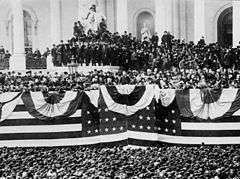
As the American Civil War broke out, Northern Democrats were divided into War Democrats and Peace Democrats. The Confederate States of America, whose political leadership, mindful of the welter prevalent in antebellum American politics and with a pressing need for unity, largely viewed political parties as inimical to good governance and consequently the Confederacy had none or at least none with the wide organization inherent to other American parties. Most War Democrats rallied to Republican President Abraham Lincoln and the Republicans' National Union Party in the election of 1864, which featured Andrew Johnson on the Republican ticket even though he was a Democrat from the South. Johnson replaced Lincoln in 1865, but he stayed independent of both parties.[40]
The Democrats benefited from white Southerners' resentment of Reconstruction after the war and consequent hostility to the Republican Party. After Redeemers ended Reconstruction in the 1870s and following the often extremely violent disenfranchisement of African Americans led by such white supremacist Democratic politicians as Benjamin Tillman of South Carolina in the 1880s and 1890s, the South, voting Democratic, became known as the "Solid South". Although Republicans won all but two presidential elections, the Democrats remained competitive. The party was dominated by pro-business Bourbon Democrats led by Samuel J. Tilden and Grover Cleveland, who represented mercantile, banking, and railroad interests; opposed imperialism and overseas expansion; fought for the gold standard; opposed bimetallism; and crusaded against corruption, high taxes and tariffs. Cleveland was elected to non-consecutive presidential terms in 1884 and 1892.[41]
20th century
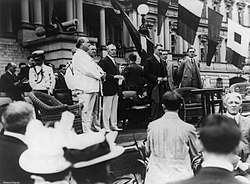
Agrarian Democrats demanding free silver, drawing on Populist ideas, overthrew the Bourbon Democrats in 1896 and nominated William Jennings Bryan for the presidency (a nomination repeated by Democrats in 1900 and 1908). Bryan waged a vigorous campaign attacking Eastern moneyed interests, but he lost to Republican William McKinley.[42]
The Democrats took control of the House in 1910, and Woodrow Wilson won election as president in 1912 (when the Republicans split) and 1916. Wilson effectively led Congress to put to rest the issues of tariffs, money and antitrust, which had dominated politics for 40 years, with new progressive laws. He failed to secure Senate passage of the Versailles Treaty (ending the war with Germany and joining the League of Nations).[43] The weak party was deeply divided by issues such as the KKK and prohibition in the 1920s. However, it did organize new ethnic voters in Northern cities.[44]
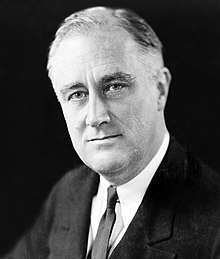
The Great Depression in 1929 that began under Republican President Herbert Hoover and the Republican Congress set the stage for a more liberal government as the Democrats controlled the House of Representatives nearly uninterrupted from 1930 until 1994, the Senate for 44 of 48 years from 1930, and won most presidential elections until 1968. Franklin D. Roosevelt, elected to the presidency in 1932, came forth with federal government programs called the New Deal. New Deal liberalism meant the regulation of business (especially finance and banking) and the promotion of labor unions as well as federal spending to aid the unemployed, help distressed farmers and undertake large-scale public works projects. It marked the start of the American welfare state.[45] The opponents, who stressed opposition to unions, support for business and low taxes, started calling themselves "conservatives".[46]
Until the 1980s, the Democratic Party was a coalition of two parties divided by the Mason–Dixon line: liberal Democrats in the North and culturally conservative voters in the South, who though benefitting from many of the New Deal public works projects opposed increasing civil rights initiatives advocated by Northeastern liberals. The polarization grew stronger after Roosevelt died. Southern Democrats formed a key part of the bipartisan conservative coalition in an alliance with most of the Midwestern Republicans. The economically activist philosophy of Franklin D. Roosevelt, which has strongly influenced American liberalism, shaped much of the party's economic agenda after 1932.[47] From the 1930s to the mid-1960s, the liberal New Deal coalition usually controlled the presidency while the conservative coalition usually controlled Congress.[48]
Issues facing parties and the United States after World War II included the Cold War and the Civil Rights Movement. Republicans attracted conservatives and, after the 1960s, white Southerners from the Democratic coalition with their use of the Southern strategy and resistance to New Deal and Great Society liberalism. Until the 1950s, African Americans had traditionally supported the Republican Party because of its anti-slavery civil rights policies. Following the passage of the Civil Rights Act of 1964 and Voting Rights Act of 1965, the Southern states became more reliably Republican in presidential politics, while Northeastern states became more reliably Democratic.[49][50][51][52][53][54][55][56] Studies show that Southern whites, which were a core constituency in the Democratic Party, shifted to the Republican Party due to racial conservatism.[55][57][58]
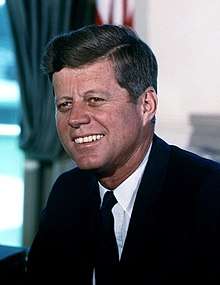
The election of President John F. Kennedy from Massachusetts in 1960 was a partial reflection of this shift. In the campaign, Kennedy attracted a new generation of younger voters. In his agenda dubbed the New Frontier, Kennedy introduced a host of social programs and public works projects, along with enhanced support of the space program, proposing a manned spacecraft trip to the moon by the end of the decade. He pushed for civil rights initiatives and proposed the Civil Rights Act of 1964, but with his assassination in November 1963, he was not able to see its passage.[59]
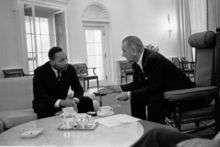
Kennedy's successor Lyndon B. Johnson was able to persuade the largely conservative Congress to pass the Civil Rights Act of 1964 and with a more progressive Congress in 1965 passed much of the Great Society, which consisted of an array of social programs designed to help the poor. Kennedy and Johnson's advocacy of civil rights further solidified black support for the Democrats but had the effect of alienating Southern whites who would eventually gravitate towards the Republican Party, particularly after the election of Ronald Reagan to the presidency in 1980. The United States' involvement in the Vietnam War in the 1960s was another divisive issue that further fractured the fault lines of the Democrats' coalition. After the Gulf of Tonkin Resolution in 1964, President Johnson committed a large contingency of combat troops to Vietnam, but the escalation failed to drive the Viet Cong from South Vietnam, resulting in an increasing quagmire, which by 1968 had become the subject of widespread anti-war protests in the United States and elsewhere. With increasing casualties and nightly news reports bringing home troubling images from Vietnam, the costly military engagement became increasingly unpopular, alienating many of the kinds of young voters that the Democrats had attracted the early 1960s. The protests that year along with assassinations of Martin Luther King Jr. and Democratic presidential candidate Senator Robert F. Kennedy (younger brother of John F. Kennedy) climaxed in turbulence at the hotly-contested Democratic National Convention that summer in Chicago (which amongst the ensuing turmoil inside and outside of the convention hall nominated Vice President Hubert Humphrey) in a series of events that proved to mark a significant turning point in the decline of the Democratic Party's broad coalition.[60]

Republican presidential nominee Richard Nixon was able to capitalize on the confusion of the Democrats that year, and won the 1968 election to become the 37th president. He won re-election in a landslide in 1972 against Democratic nominee George McGovern, who like Robert F. Kennedy, reached out to the younger anti-war and counterculture voters, but unlike Kennedy, was not able to appeal to the party's more traditional white working-class constituencies. During Nixon's second term, his presidency was rocked by the Watergate scandal, which forced him to resign in 1974. He was succeeded by vice president Gerald Ford, who served a brief tenure. Watergate offered the Democrats an opportunity to recoup, and their nominee Jimmy Carter won the 1976 presidential election. With the initial support of evangelical Christian voters in the South, Carter was temporarily able to reunite the disparate factions within the party, but inflation and the Iran Hostage Crisis of 1979–1980 took their toll, resulting in a landslide victory for Republican presidential nominee Ronald Reagan in 1980, which shifted the political landscape in favor of the Republicans for years to come.

With the ascendancy of the Republicans under Ronald Reagan, the Democrats searched for ways to respond yet were unable to succeed by running traditional candidates, such as former vice president and Democratic presidential nominee Walter Mondale, who lost to Reagan in the 1984 presidential election. Many Democrats attached their hopes to the future star of Gary Hart, who had challenged Mondale in the 1984 primaries running on a theme of "New Ideas"; and in the subsequent 1988 primaries became the de facto front-runner and virtual "shoo-in" for the Democratic presidential nomination before his campaign was ended by a sex scandal. The party nevertheless began to seek out a younger generation of leaders, who like Hart had been inspired by the pragmatic idealism of John F. Kennedy.[61]
Arkansas governor Bill Clinton was one such figure, who was elected president in 1992 as the Democratic nominee. He labeled himself and governed as a "New Democrat". The party adopted a centrist economic yet socially progressive agenda, with the voter base after Reagan having shifted considerably to the right. In an effort to appeal both to liberals and to fiscal conservatives, Democrats began to advocate for a balanced budget and market economy tempered by government intervention (mixed economy), along with a continued emphasis on social justice and affirmative action. The economic policy adopted by the Democratic Party, including the former Clinton administration, has been referred to as "Third Way". The Democrats lost control of Congress in the election of 1994 to the Republican Party. Re-elected in 1996, Clinton was the first Democratic president since Franklin D. Roosevelt to be elected to two terms.[62]
21st century
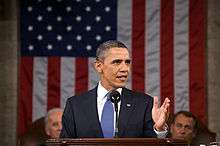
In the wake of the 2001 terrorist attacks on the World Trade Center and the Pentagon as well as the growing concern over global warming, some of the party's key issues in the early 21st century have included combating terrorism while preserving human rights, expanding access to health care, labor rights, and environmental protection. The Democrats regained majority control of both the House and the Senate in the 2006 elections. Barack Obama won the Democratic Party's nomination and was elected as the first African American president in 2008. Under the Obama presidency, the party moved forward reforms including an economic stimulus package, the Dodd–Frank financial reform act, and the Affordable Care Act. In the 2010 elections, the Democratic Party lost control of the House and lost its majority in state legislatures and state governorships. In the 2012 elections, President Obama was re-elected, but the party remained in the minority in the House of Representatives and lost control of the Senate in 2014. After the 2016 election of Donald Trump, the Democratic Party transitioned into the role of an opposition party and currently hold neither the presidency nor the Senate but won back a majority in the House in the 2018 midterm elections.[63] Democrats have been extremely critical of President Trump, particularly his policies on immigration, healthcare, and abortion, as well as his response to the COVID-19 pandemic.[64][65][66]
According to the Pew Research Center, Democrats became more secular and socially liberal between 1987 and 2012.[67] Based on a poll conducted in 2014, Gallup found that 30% of Americans identified as Democrats, 23% as Republicans and 45% as independents.[68] In the same poll, a survey of registered voters stated that 47% identified as Democrats or leaned towards the party—the same poll found that 40% of registered voters identified as Republicans or leaned towards the Republican Party.
In 2018, Democratic congressional candidate Tom Malinowski, who was later elected, described the party:
We're now the party of fiscal responsibility in America. We didn't just add $2 trillion to the national debt for that tax cut that Warren Buffett didn't want ... We're the party of law enforcement in America; we don't vilify the Federal Bureau of Investigation every single day. We're the party of family values. We don't ... take kids from their parents at the border. We're the party of patriotism in America that wants to defend this country against our foreign adversaries.
— Tom Malinowski in July 2018[69]
Name and symbols

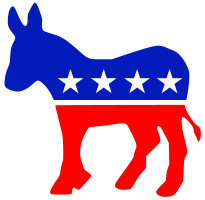

The Democratic-Republican Party splintered in 1824 into the short-lived National Republican Party and the Jacksonian movement which in 1828 became the Democratic Party. Under the Jacksonian era, the term "The Democracy" was in use by the party, but the name "Democratic Party" was eventually settled upon[70] and became the official name in 1844.[71] Members of the party are called "Democrats" or "Dems".
The term "Democrat Party" has also been in local use, but has usually been used by opponents since 1952 as a disparaging term.
The most common mascot symbol for the party has been the donkey, or jackass.[72] Andrew Jackson's enemies twisted his name to "jackass" as a term of ridicule regarding a stupid and stubborn animal. However, the Democrats liked the common-man implications and picked it up too, therefore the image persisted and evolved.[73] Its most lasting impression came from the cartoons of Thomas Nast from 1870 in Harper's Weekly. Cartoonists followed Nast and used the donkey to represent the Democrats and the elephant to represent the Republicans.
In the early 20th century, the traditional symbol of the Democratic Party in Indiana, Kentucky, Oklahoma and Ohio was the rooster, as opposed to the Republican eagle. This symbol still appears on Oklahoma, Kentucky, Indiana, and West Virginia ballots.[74] The rooster was adopted as the official symbol of the national Democratic Party.[75] In New York, the Democratic ballot symbol is a five-pointed star.[76]
Although both major political parties (and many minor ones) use the traditional American colors of red, white and blue in their marketing and representations, since election night 2000 blue has become the identifying color for the Democratic Party while red has become the identifying color for the Republican Party. That night, for the first time all major broadcast television networks used the same color scheme for the electoral map: blue states for Al Gore (Democratic nominee) and red states for George W. Bush (Republican nominee). Since then, the color blue has been widely used by the media to represent the party. This is contrary to common practice outside of the United States where blue is the traditional color of the right and red the color of the left.[77] For example, in Canada red represents the Liberals while blue represents the Conservatives. In the United Kingdom, red denotes the Labour Party and blue symbolizes the Conservative Party. Any use of the color blue to denote the Democratic Party prior to 2000 would be historically inaccurate and misleading. Since 2000, blue has also been used both by party supporters for promotional efforts—ActBlue, BuyBlue and BlueFund as examples—and by the party itself in 2006 both for its "Red to Blue Program", created to support Democratic candidates running against Republican incumbents in the midterm elections that year and on its official website.
In September 2010, the Democratic Party unveiled its new logo, which featured a blue D inside a blue circle. It was the party's first official logo; the donkey logo had only been semi-official.
Jefferson-Jackson Day is the annual fundraising event (dinner) held by Democratic Party organizations across the United States.[78] It is named after Presidents Thomas Jefferson and Andrew Jackson, whom the party regards as its distinguished early leaders.
The song "Happy Days Are Here Again" is the unofficial song of the Democratic Party. It was used prominently when Franklin D. Roosevelt was nominated for president at the 1932 Democratic National Convention and remains a sentimental favorite for Democrats today. For example, Paul Shaffer played the theme on the Late Show with David Letterman after the Democrats won Congress in 2006. "Don't Stop" by Fleetwood Mac was adopted by Bill Clinton's presidential campaign in 1992 and has endured as a popular Democratic song. The emotionally similar song "Beautiful Day" by the band U2 has also become a favorite theme song for Democratic candidates. John Kerry used the song during his 2004 presidential campaign and several Democratic Congressional candidates used it as a celebratory tune in 2006.[79][80]
The 2016 campaign of Democratic Party presidential candidate Bernie Sanders used the hopeful Simon & Garfunkel song "America" for one of its campaign advertisements,[81] with the complete permission of the still-active duo of popular American musicians.[82] As a traditional anthem for its presidential nominating convention, Aaron Copland's "Fanfare for the Common Man" is traditionally performed at the beginning of the Democratic National Convention.
Current structure and composition
National committee
The Democratic National Committee (DNC) is responsible for promoting Democratic campaign activities. While the DNC is responsible for overseeing the process of writing the Democratic Platform, the DNC is more focused on campaign and organizational strategy than public policy. In presidential elections, it supervises the Democratic National Convention. The national convention is subject to the charter of the party and the ultimate authority within the Democratic Party when it is in session, with the DNC running the party's organization at other times. The DNC is chaired by former Labor Secretary Tom Perez.[83]
State parties
Each state also has a state committee, made up of elected committee members as well as ex officio committee members (usually elected officials and representatives of major constituencies), which in turn elects a chair. County, town, city and ward committees generally are composed of individuals elected at the local level. State and local committees often coordinate campaign activities within their jurisdiction, oversee local conventions and in some cases primaries or caucuses and may have a role in nominating candidates for elected office under state law. Rarely do they have much funding, but in 2005 DNC Chairman Dean began a program (called the "50 State Strategy") of using DNC national funds to assist all state parties and pay for full-time professional staffers.[84]
Major party groups
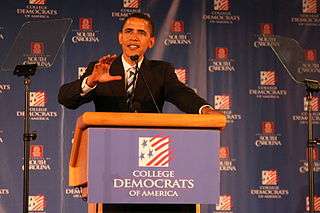
The Democratic Congressional Campaign Committee (DCCC) assists party candidates in House races and its current chairman (selected by the party caucus) is Representative Cheri Bustos of Illinois. Similarly, the Democratic Senatorial Campaign Committee (DSCC), headed by Senator Catherine Cortez Masto of Nevada, raises funds for Senate races. The Democratic Legislative Campaign Committee (DLCC), chaired by Oregon legislator Tina Kotek, is a smaller organization with much less funding that focuses on state legislative races. The DNC sponsors the College Democrats of America (CDA), a student-outreach organization with the goal of training and engaging a new generation of Democratic activists. Democrats Abroad is the organization for Americans living outside the United States and they work to advance the goals of the party and encourage Americans living abroad to support the Democrats. The Young Democrats of America (YDA) is a youth-led organization that attempts to draw in and mobilize young people for Democratic candidates but operates outside of the DNC. The Democratic Governors Association (DGA), chaired by Governor Gina Raimondo of Rhode Island,[85] is an organization supporting the candidacies of Democratic gubernatorial nominees and incumbents. Likewise, the mayors of the largest cities and urban centers convene as the National Conference of Democratic Mayors.[86]
Ideology
Upon foundation, the Democratic Party supported agrarianism and the Jacksonian democracy movement of President Andrew Jackson, representing farmers and rural interests and traditional Jeffersonian democrats.[87] Since the 1890s, especially in northern states, the party began to favor more liberal positions (the term "liberal" in this sense describes modern liberalism, rather than classical liberalism or economic liberalism). In recent exit polls, the Democratic Party has had broad appeal across all socio-ethno-economic demographics.[88][89][90]
Historically, the party has represented farmers, laborers, labor unions and religious and ethnic minorities as it has opposed unregulated business and finance and favored progressive income taxes. In foreign policy, internationalism (including interventionism) was a dominant theme from 1913 to the mid-1960s. In the 1930s, the party began advocating welfare spending programs targeted at the poor. The party had a fiscally conservative, pro-business wing, typified by Grover Cleveland and Al Smith; and a Southern conservative wing that shrank after President Lyndon B. Johnson supported the Civil Rights Act of 1964. The major influences for liberalism were labor unions (which peaked in the 1936–1952 era) and the African American wing, which has steadily grown since the 1960s. Since the 1970s, environmentalism has been a major new component. The 21st century Democratic Party is predominantly a coalition of centrists, liberals, and progressives, with significant overlap between the three groups.[91]
The Democratic Party, once dominant in the Southeastern United States, is now strongest in the Northeast (Mid-Atlantic and New England), the Great Lakes region, and the West Coast (including Hawaii). The party is also very strong in major cities (regardless of region).[30]
Centrists
Centrist Democrats, or New Democrats, are an ideologically centrist faction within the Democratic Party that emerged after the victory of Republican George H. W. Bush in the 1988 presidential election. They are an economically liberal and "Third Way" faction which dominated the party for around 20 years starting in the late 1980s after the United States populace turned much further to the political right. They are represented by organizations such as the New Democrat Network and the New Democrat Coalition. The New Democrat Coalition is a pro-growth and fiscally moderate congressional coalition.[92]
One of the most influential centrist groups was the Democratic Leadership Council (DLC), a nonprofit organization that advocated centrist positions for the party. The DLC hailed President Bill Clinton as proof of the viability of "Third Way" politicians and a DLC success story. The DLC disbanded in 2011 and much of the former DLC is now represented in the think tank Third Way.[93]
While not representing a majority of the Democratic Party electorate, some Democratic elected officials have self-declared as being centrists. These Democrats include former President Bill Clinton, former Vice President Al Gore, Senator Mark Warner, former Pennsylvania governor Ed Rendell, former Senator Jim Webb, former Vice President Joe Biden, congresswoman Ann Kirkpatrick, and former congressman Dave McCurdy.[94][95]
The New Democrat Network supports socially liberal and fiscally moderate Democratic politicians and is associated with the congressional New Democrat Coalition in the House.[96] Congressman Derek Kilmer is the chair of the coalition,[94] and former senator and 2016 Democratic presidential nominee Hillary Clinton was a member while in Congress.[97] In 2009, President Barack Obama was self-described as a New Democrat.[98]
Conservatives
A conservative Democrat is a member of the Democratic Party with conservative political views, or with views relatively conservative with respect to those of the national party. While such members of the Democratic Party can be found throughout the nation, actual elected officials are disproportionately found within the Southern states and to a lesser extent within rural regions of the United States generally, more commonly in the West. Historically, Southern Democrats were generally much more ideologically conservative than conservative Democrats are now.

Many conservative Southern Democrats defected to the Republican Party, beginning with the passage of the Civil Rights Act of 1964 and the general leftward shift of the party. Strom Thurmond of South Carolina, Billy Tauzin of Louisiana, Kent Hance and Ralph Hall of Texas and Richard Shelby of Alabama are examples of this. The influx of conservative Democrats into the Republican Party is often cited as a reason for the Republican Party's shift further to the right during the late 20th century as well as the shift of its base from the Northeast and Midwest to the South.
Into the 1980s, the Democratic Party had a conservative element, mostly from the South and Border regions. Their numbers declined sharply as the Republican Party built up its Southern base. They were sometimes humorously called "Yellow dog Democrats", or "boll weevils" and "Dixiecrats". In the House, they form the Blue Dog Coalition, a caucus of conservatives and centrists willing to broker compromises with the Republican leadership. They have acted as a unified voting bloc in the past, giving its members some ability to change legislation, depending on their numbers in Congress.
Split-ticket voting was common among conservative Southern Democrats in the 1970s and 1980s. These voters supported conservative Democrats for local and statewide office while simultaneously voting for Republican presidential candidates.[99]
Liberals

Social liberals (modern liberals) are a large portion of the Democratic base. According to 2018 exit polls, liberals constituted 27% of the electorate, and 91% of American liberals favored the candidate of the Democratic Party.[100] White-collar college-educated professionals were mostly Republican until the 1950s, but they now compose a vital component of the Democratic Party.[101]
A large majority of liberals favor moving toward universal health care, with many supporting a single-payer system. A majority also favor diplomacy over military action, stem cell research, the legalization of same-sex marriage, stricter gun control and environmental protection laws as well as the preservation of abortion rights. Immigration and cultural diversity are deemed positive as liberals favor cultural pluralism, a system in which immigrants retain their native culture in addition to adopting their new culture. They tend to be divided on free trade agreements such as the North American Free Trade Agreement (NAFTA) and organizations, with some seeing them as more favorable to corporations than workers. Most liberals oppose increased military spending and the mixing of church and state.[102]
This ideological group differs from the traditional organized labor base. According to the Pew Research Center, a plurality of 41% resided in mass affluent households and 49% were college graduates, the highest figure of any typographical group. It was also the fastest growing typological group between the late 1990s and early 2000s.[102] Liberals include most of academia[103] and large portions of the professional class.[88][89][90]
Progressives
Progressives are the most left-leaning faction in the party and support strong business regulations, social programs, and workers' rights.[104][105] Many progressive Democrats are descendants of the New Left of Democratic presidential candidate Senator George McGovern of South Dakota whereas others were involved in the 2016 presidential candidacy of Vermont Senator Bernie Sanders. Progressives are often considered to be synonymous with liberals, though progressives are sometimes considered to show stronger support for universal health care, solutions for economic inequality, and environmental regulations.[106]
In 2014, progressive Senator Elizabeth Warren set out "Eleven Commandments of Progressivism": tougher regulation on corporations, affordable education, scientific investment and environmentalism, net neutrality, increased wages, equal pay for women, collective bargaining rights, defending social programs, marriage equality, immigration reform, and unabridged access to reproductive healthcare.[107] In addition, progressives strongly oppose political corruption and seek to advance electoral reforms such as campaign finance rules and voting rights protections.[108] Today, many progressives have made combating economic inequality their top priority.[109]
The Congressional Progressive Caucus (CPC) is a caucus of progressive Democrats chaired by Representatives Mark Pocan of Wisconsin and Pramila Jayapal of Washington.[110] Its members have included Representatives Dennis Kucinich of Ohio, John Conyers of Michigan, Jim McDermott of Washington, John Lewis of Georgia, Barbara Lee of California, and Senator Paul Wellstone of Minnesota. Senators Sherrod Brown of Ohio, Tammy Baldwin of Wisconsin, Mazie Hirono of Hawaii, and Ed Markey of Massachusetts were members of the caucus when in the House of Representatives. While no Democratic Senators currently belong to the CPC, independent Senator Bernie Sanders is a member.[111]
Political positions
- Economic policy
- Expand Social Security and safety net programs.[112]
- Increase top capital gains tax and dividend tax rates to above 28%.[113]
- Across-the-board tax cuts for the working and middle classes as well as small businesses.[114]
- Change tax rules to not encourage shipping jobs overseas.[114]
- Increase federal and state minimum wages.[115]
- Modernize and expand access to public education and provide universal preschool education.[116]
- Support for universal health care.[117]
- Greater investment in infrastructure development.[118]
- Increase investments in scientific and technological research and development.[119]
- Expand the use of renewable energy and diminish the use of fossil fuels.[120]
- Implement a carbon tax.[121]
- Uphold labor protections and the right to unionize.[122][123]
- Reform the student loan system and allow for refinancing student loans.[124]
- Make college more affordable.[115][125]
- Mandate equal pay for equal work regardless of gender, race, or ethnicity.[126]
- Social policy
- Decriminalization or legalization of marijuana.[115]
- Uphold network neutrality.[127]
- Implement campaign finance reform and electoral reform.[23]
- Uphold voting rights and easy access to voting.[128][129]
- Support for same-sex marriage and civil unions. Bans on conversion therapy.[115]
- Allow legal access to abortions and women's reproductive health care.[118]
- Reform the immigration system and allow for a pathway to citizenship.[118]
- Support for gun background checks and stricter gun control regulations.[118]
- Improve privacy laws and curtail government surveillance.[118]
- Opposition to the use of torture.[130][131]
- Recognize and defend Internet freedom worldwide.[114]
Economic issues
Equal economic opportunity, a base social safety net provided by the welfare state and strong labor unions have historically been at the heart of Democratic economic policy.[20] The welfare state supports a progressive tax system, higher minimum wages, Social Security, universal health care, public education and public housing.[20] They also support infrastructure development and government-sponsored employment programs in an effort to achieve economic development and job creation while stimulating private sector job creation.[132] Additionally, since the 1990s the party has at times supported centrist economic reforms, which cut the size of government and reduced market regulations.[133] The party has generally rejected laissez-faire economics as well as market socialism, instead favoring Keynesian economics within a capitalist market-based system.[134]
Fiscal policy
Democrats support a more progressive tax structure to provide more services and reduce economic inequality by making sure that the wealthiest Americans pay the highest amount in taxes.[135] Democrats support more government spending on social services while spending less on the military.[136][137] They oppose the cutting of social services, such as Social Security, Medicare, Medicaid and various other welfare programs,[138] believing it to be harmful to efficiency and social justice. Democrats believe the benefits of social services in monetary and non-monetary terms are a more productive labor force and cultured population and believe that the benefits of this are greater than any benefits that could be derived from lower taxes, especially on top earners, or cuts to social services. Furthermore, Democrats see social services as essential towards providing positive freedom, freedom derived from economic opportunity. The Democratic-led House of Representatives reinstated the PAYGO (pay-as-you-go) budget rule at the start of the 110th Congress.[139]
Minimum wage
The Democratic Party favors raising the minimum wage. The Fair Minimum Wage Act of 2007 was an early component of the Democrats' agenda during the 110th Congress. In 2006, the Democrats supported six state ballot initiatives to increase the minimum wage and all six initiatives passed.[140] In May 2017, Senate Democrats introduced the Raise the Wage Act which would raise the minimum wage to $15 an hour by 2024 and marks a leftward turn in Democratic economic policies.[141]
Health care

Democrats call for "affordable and quality health care" and favor moving toward universal health care in a variety of forms to address rising healthcare costs. Some Democratic politicians favor a single-payer program or Medicare for All, while others prefer creating a public health insurance option.[142]
The Patient Protection and Affordable Care Act, signed into law by President Barack Obama on March 23, 2010, has been one of the most significant pushes for universal health care. As of December 2019, more than 20 million Americans have gained health insurance under the Affordable Care Act.[143]
Education
Democrats favor improving public education by raising school standards and reforming the Head Start program. They also support universal preschool and expanding access to primary education, including through charter schools. They call for addressing student loan debt and reforms to reduce college tuition.[144] Other proposals have included tuition-free public universities and reform of standardized testing. Democrats have the long-term aim of having publicly funded college education with low tuition fees (like in much of Europe and Canada), which would be available to every eligible American student. Alternatively, they encourage expanding access to post-secondary education by increasing state funding for student financial aid such as Pell Grants and college tuition tax deductions.[145]
Environment
.jpg)
Democrats believe that the government should protect the environment and have a history of environmentalism. In more recent years, this stance has emphasized renewable energy generation as the basis for an improved economy, greater national security, and general environmental benefits.[146]
The Democratic Party also favors expansion of conservation lands and encourages open space and rail travel to relieve highway and airport congestion and improve air quality and economy as it "believe[s] that communities, environmental interests, and the government should work together to protect resources while ensuring the vitality of local economies. Once Americans were led to believe they had to make a choice between the economy and the environment. They now know this is a false choice".[147]
The foremost environmental concern of the Democratic Party is climate change. Democrats, most notably former Vice President Al Gore, have pressed for stern regulation of greenhouse gases. On October 15, 2007, Gore won the Nobel Peace Prize for his efforts to build greater knowledge about man-made climate change and laying the foundations for the measures needed to counteract it.[148]
Renewable energy and fossil fuels
Democrats have supported increased domestic renewable energy development, including wind and solar power farms, in an effort to reduce carbon pollution. The party's platform calls for an "all of the above" energy policy including clean energy, natural gas and domestic oil, with the desire of becoming energy independent.[140] The party has supported higher taxes on oil companies and increased regulations on coal power plants, favoring a policy of reducing long-term reliance on fossil fuels.[149][150] Additionally, the party supports stricter fuel emissions standards to prevent air pollution.
Trade agreements
Many Democrats support fair trade policies when it comes to the issue of international trade agreements and some in the party have started supporting free trade in recent decades.[151] In the 1990s, the Clinton administration and a number of prominent Democrats pushed through a number of agreements such as the North American Free Trade Agreement (NAFTA). Since then, the party's shift away from free trade became evident in the Central American Free Trade Agreement (CAFTA) vote, with 15 House Democrats voting for the agreement and 187 voting against.[152][153]
Social issues

The modern Democratic Party emphasizes egalitarianism and social equality through liberalism. They support voting rights and minority rights, including LGBT rights, multiculturalism and religious secularism. A longstanding social policy is upholding civil rights, which affect ethnic and racial minorities and includes voting rights, equal opportunity and racial equality. The party championed the Civil Rights Act of 1964, which for the first time outlawed segregation. Democrats made civil rights and anti-racism a core party philosophy. Carmines and Stimson say that "the Democratic Party appropriated racial liberalism and assumed federal responsibility for ending racial discrimination".[154][155][156]
Ideological social elements in the party include cultural liberalism, civil libertarianism and feminism. Other Democratic social policies are internationalism, openness to immigration, electoral reform and women's reproductive rights.
Equal opportunity
The Democratic Party supports equal opportunity for all Americans regardless of sex, age, race, ethnicity, sexual orientation, gender identity, religion, creed, or national origin. Many Democrats support affirmative action programs to further this goal. Democrats also strongly support the Americans with Disabilities Act to prohibit discrimination against people based on physical or mental disability. As such, the Democrats pushed as well the ADA Amendments Act of 2008, a disability rights expansion that became law.[157]
Voting rights
The party is very supportive of improving voting rights as well as election accuracy and accessibility.[158] They support ending voter ID laws and increasing voting time, including making election day a holiday. They support reforming the electoral system to eliminate gerrymandering as well as passing comprehensive campaign finance reform.[23] They supported the Voting Rights Act of 1965 and as a party have often been pioneers for democracy in the United States.[129]
Abortion and reproductive rights
The Democratic Party believe that all women should have access to birth control and support public funding of contraception for poor women. In its national platforms from 1992 to 2004, the Democratic Party has called for abortion to be "safe, legal and rare"—namely, keeping it legal by rejecting laws that allow governmental interference in abortion decisions and reducing the number of abortions by promoting both knowledge of reproduction and contraception and incentives for adoption. The wording changed in the 2008 platform. When Congress voted on the Partial-Birth Abortion Ban Act in 2003, Congressional Democrats were split, with a minority (including former Senate Majority Leader Harry Reid) supporting the ban and the majority of Democrats opposing the legislation.[159]
The Democratic Party opposes attempts to reverse the 1973 Supreme Court decision Roe v. Wade, which declared abortion covered by the constitutionally protected individual right to privacy under the Ninth Amendment; and Planned Parenthood v. Casey, which lays out the legal framework in which government action alleged to violate that right is assessed by courts. As a matter of the right to privacy and of gender equality, many Democrats believe all women should have the ability to choose to abort without governmental interference. They believe that each woman, conferring with her conscience, has the right to choose for herself whether abortion is morally correct.
Former Senate Minority Leader Harry Reid was anti-abortion and former President Jimmy Carter has expressed his wish to see the Democratic Party becoming more pro-life,[160] while former President Barack Obama and Speaker of the House Nancy Pelosi favor abortion rights. Groups such as Democrats for Life of America represent the anti-abortion faction of the party while groups such as EMILY's List represent the abortion rights faction. A Newsweek poll from October 2006 found that 25% of Democrats were anti-abortion while a 69% majority was in favor of abortion rights.[161]
The 2016 Democratic Party platform expresses support for "'a woman's right to safe and legal abortion' and enumerates no limits on that right."[162] It further calls for the repeal of the Hyde Amendment, which prohibits the use of federal tax dollars for elective abortions.[163]
Immigration
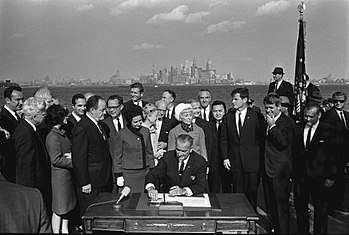
Many Democratic politicians have called for systematic reform of the immigration system such that residents that have come into the United States illegally have a pathway to legal citizenship. President Obama remarked in November 2013 that he felt it was "long past time to fix our broken immigration system", particularly to allow "incredibly bright young people" that came over as students to become full citizens. The Public Religion Research Institute found in a late 2013 study that 73% of Democrats supported the pathway concept, compared to 63% of Americans as a whole.[164]
In 2013, Democrats in the Senate passed S.744, which would reform immigration policy to allow citizenship for illegal immigrants in the United States and improve the lives of all immigrants currently living in the United States.[165]
LGBT rights
The Democratic Party is supportive of LGBT rights. Most support for same-sex marriage in the United States has come from Democrats. Support for same-sex marriage has increased in the past decade according to ABC News. An April 2009 ABC News/Washington Post public opinion poll put support among Democrats at 62%[166] whereas a June 2008 Newsweek poll found that 42% of Democrats support same-sex marriage while 23% support civil unions or domestic partnership laws and 28% oppose any legal recognition at all.[167] A broad majority of Democrats have supported other LGBT-related laws such as extending hate crime statutes, legally preventing discrimination against LGBT people in the workforce and repealing Don't ask, don't tell. A 2006 Pew Research Center poll of Democrats found that 55% supported gays adopting children with 40% opposed while 70% support gays in the military, with only 23% opposed.[168] Gallup polling from May 2009 stated that 82% of Democrats support open enlistment.[169]
The 2004 Democratic National Platform stated that marriage should be defined at the state level and it repudiated the Federal Marriage Amendment.[170] While not stating support of same-sex marriage, the 2008 platform called for repeal of the Defense of Marriage Act, which banned federal recognition of same-sex marriage and removed the need for interstate recognition, supported antidiscrimination laws and the extension of hate crime laws to LGBT people and opposed the Don't ask, don't tell military policy.[171] The 2012 platform included support for same-sex marriage and for the repeal of DOMA.[24]
On May 9, 2012, Barack Obama became the first sitting president to say he supports same-sex marriage.[172][173] Previously, he had opposed restrictions on same-sex marriage such as the Defense of Marriage Act, which he promised to repeal,[174] California's Prop 8,[175] and a constitutional amendment to ban same-sex marriage (which he opposed saying that "decisions about marriage should be left to the states as they always have been"),[176] but also stated that he personally believed marriage to be between a man and a woman and that he favored civil unions that would "give same-sex couples equal legal rights and privileges as married couples".[174] Earlier, when running for the Illinois Senate in 1996 he said, "I favor legalizing same-sex marriages, and would fight efforts to prohibit such marriages".[177] John Kerry, Democratic presidential candidate in 2004, did not support same-sex marriage. Former presidents Bill Clinton[178] and Jimmy Carter[179] and former Vice Presidents Joe Biden, Al Gore[180] and Walter Mondale[181] also support gay marriage.
Puerto Rico
The 2016 Democratic Party platform declares: "We are committed to addressing the extraordinary challenges faced by our fellow citizens in Puerto Rico. Many stem from the fundamental question of Puerto Rico's political status. Democrats believe that the people of Puerto Rico should determine their ultimate political status from permanent options that do not conflict with the Constitution, laws, and policies of the United States. Democrats are committed to promoting economic opportunity and good-paying jobs for the hardworking people of Puerto Rico. We also believe that Puerto Ricans must be treated equally by Medicare, Medicaid, and other programs that benefit families. Puerto Ricans should be able to vote for the people who make their laws, just as they should be treated equally. All American citizens, no matter where they reside, should have the right to vote for the President of the United States. Finally, we believe that federal officials must respect Puerto Rico's local self-government as laws are implemented and Puerto Rico's budget and debt are restructured so that it can get on a path towards stability and prosperity".[118]
Legal issues
Gun control
With a stated goal of reducing crime and homicide, the Democratic Party has introduced various gun control measures, most notably the Gun Control Act of 1968, the Brady Bill of 1993 and Crime Control Act of 1994. However, some Democrats, especially rural, Southern, and Western Democrats, favor fewer restrictions on firearm possession and warned the party was defeated in the 2000 presidential election in rural areas because of the issue.[182] In the national platform for 2008, the only statement explicitly favoring gun control was a plan calling for renewal of the 1994 Assault Weapons Ban.[183]
Death penalty
The Democratic Party supports the death penalty far less than the Republican Party. Although most Democrats in Congress have never seriously moved to overturn the rarely used federal death penalty, both Russ Feingold and Dennis Kucinich have introduced such bills with little success. Democrats have led efforts to overturn state death penalty laws, particularly in New Jersey and in New Mexico. They have also sought to prevent the reinstatement of the death penalty in those states which prohibit it, including Massachusetts and New York. During the Clinton administration, Democrats led the expansion of the federal death penalty. These efforts resulted in the passage of the Antiterrorism and Effective Death Penalty Act of 1996, signed into law by President Clinton, which heavily limited appeals in death penalty cases.
In 1992, 1993 and 1995, Democratic Texas Congressman Henry González unsuccessfully introduced the Death Penalty Abolition Amendment which prohibited the use of capital punishment in the United States. Democratic Missouri Congressman William Lacy Clay, Sr. cosponsored the amendment in 1993.
During his Illinois Senate career, former President Barack Obama successfully introduced legislation intended to reduce the likelihood of wrongful convictions in capital cases, requiring videotaping of confessions. When campaigning for the presidency, Obama stated that he supports the limited use of the death penalty, including for people who have been convicted of raping a minor under the age of 12, having opposed the Supreme Court's ruling in Kennedy v. Louisiana that the death penalty was unconstitutional in child rape cases.[184] Obama has stated that he thinks the "death penalty does little to deter crime" and that it is used too frequently and too inconsistently.[185]
In June 2016, the Democratic Platform Drafting Committee unanimously adopted an amendment to abolish the death penalty, marking the first time the party had done so in its history.[186]
Torture
Many Democrats are opposed to the use of torture against individuals apprehended and held prisoner by the United States military and hold that categorizing such prisoners as unlawful combatants does not release the United States from its obligations under the Geneva Conventions. Democrats contend that torture is inhumane, damages the United States' moral standing in the world, and produces questionable results. Democrats are largely against waterboarding.[187]
Torture became a divisive issue in the party after Barack Obama was elected president.[188]
Patriot Act
Many Democrats are opposed to the Patriot Act, but when the law was passed most Democrats were supportive of it and all but two Democrats in the Senate voted for the original Patriot Act legislation in 2001. The lone nay vote was from Russ Feingold of Wisconsin as Mary Landrieu of Louisiana did not vote.[189] In the House, the Democrats voted for the Act by 145 yea and 62 nay. Democrats were split on the renewal in 2006. In the Senate, Democrats voted 34 for the 2006 renewal and nine against. In the House, Democrats voted 66 voted for the renewal and 124 against.[190]
Privacy
The Democratic Party believes that individuals should have a right to privacy. For example, many Democrats have opposed the NSA warrantless surveillance of American citizens.
Some Democratic officeholders have championed consumer protection laws that limit the sharing of consumer data between corporations. Most Democrats oppose sodomy laws and believe that government should not regulate consensual noncommercial sexual conduct among adults as a matter of personal privacy.[191]
Foreign policy issues
The foreign policy of the voters of the two major parties has largely overlapped since the 1990s. A Gallup poll in early 2013 showed broad agreement on the top issues, albeit with some divergence regarding human rights and international cooperation through agencies such as the United Nations.[192]
In June 2014, the Quinnipiac Poll asked Americans which foreign policy they preferred:
A) The United States is doing too much in other countries around the world, and it is time to do less around the world and focus more on our own problems here at home. B) The United States must continue to push forward to promote democracy and freedom in other countries around the world because these efforts make our own country more secure.
Democrats chose A over B by 65% to 32%; Republicans chose A over B by 56% to 39%; and independents chose A over B by 67% to 29%.[193]
Iraq War

In 2002, Congressional Democrats were divided on the Authorization for Use of Military Force Against Iraq: 147 voted against it (21 in the Senate and 126 in the House) and 110 voted for it (29 in the Senate and 81 in the House). Since then, many prominent Democrats, such as former senator John Edwards, have expressed regret about this decision and have called it a mistake while others, such as Senator Hillary Clinton, have criticized the conduct of the war yet not repudiated their initial vote for it (though Clinton later went on to repudiate her stance during the 2008 primaries). Referring to Iraq, Senate Majority Leader Harry Reid declared in April 2007 the war to be "lost" while other Democrats (especially during the 2004 presidential election cycle) accused the President of lying to the public about weapons of mass destruction in Iraq. Among lawmakers, Democrats are the most vocal opponents of Operation Iraqi Freedom and campaigned on a platform of withdrawal ahead of the 2006 midterm elections.
A March 2003 CBS News poll taken a few days before the invasion of Iraq found that 34% of Democrats nationwide would support it without United Nations backing, 51% would support it only with its backing and 14% would not support it at all.[194] The Los Angeles Times stated in early April 2003 that 70% of Democrats supported the decision to invade while 27% opposed it.[195] The Pew Research Center stated in August 2007 that opposition increased from 37% during the initial invasion to 74%.[196] In April 2008, a CBS News poll found that about 90% of Democrats disapprove of the Bush administration's conduct and want to end the war within the next year.[197]
Democrats in the House of Representatives near-unanimously supported a non-binding resolution disapproving of President Bush's decision to send additional troops into Iraq in 2007. Congressional Democrats overwhelmingly supported military funding legislation that included a provision that set "a timeline for the withdrawal of all US combat troops from Iraq" by March 31, 2008, but also would leave combat forces in Iraq for purposes such as targeted counter-terrorism operations.[198][199] After a veto from the President and a failed attempt in Congress to override the veto,[200] the U.S. Troop Readiness, Veterans' Care, Katrina Recovery, and Iraq Accountability Appropriations Act, 2007 was passed by Congress and signed by the President after the timetable was dropped. Criticism of the Iraq War subsided after the Iraq War troop surge of 2007 led to a dramatic decrease in Iraqi violence. The Democratic-controlled 110th Congress continued to fund efforts in both Iraq and Afghanistan. Presidential candidate Barack Obama advocated a withdrawal of combat troops within Iraq by late 2010 with a residual force of peacekeeping troops left in place.[201] He stated that both the speed of withdrawal and the number of troops left over would be "entirely conditions-based".[201]
On February 27, 2009, President Obama announced: "As a candidate for president, I made clear my support for a timeline of 16 months to carry out this drawdown, while pledging to consult closely with our military commanders upon taking office to ensure that we preserve the gains we've made and protect our troops [...] Those consultations are now complete, and I have chosen a timeline that will remove our combat brigades over the next 18 months".[202] Around 50,000 non-combat-related forces would remain.[202] Obama's plan drew wide bipartisan support, including that of defeated Republican presidential candidate Senator John McCain.[202]
Iran sanctions
The Democratic Party has been critical of the Iran's nuclear weapon program and supported economic sanctions against the Iranian government. In 2013, the Democratic-led administration worked to reach a diplomatic agreement with the government of Iran to halt the Iranian nuclear weapon program in exchange for international economic sanction relief.[203] As of 2014, negotiations had been successful and the party called for more cooperation with Iran in the future.[204] In 2015, the Obama administration agreed to the Joint Comprehensive Plan of Action, which provides sanction relief in exchange for international oversight of the Iranian nuclear program. In February 2019, the Democratic National Committee passed a resolution calling on the United States to re-enter the JCPOA, which President Trump withdrew from in 2018.[205]
Invasion of Afghanistan
Democrats in the House of Representatives and in the Senate near-unanimously voted for the Authorization for Use of Military Force Against Terrorists against "those responsible for the recent attacks launched against the United States" in Afghanistan in 2001, supporting the NATO coalition invasion of the nation. Most elected Democrats continue to support the Afghanistan conflict and some, such as a Democratic National Committee spokesperson, have voiced concerns that the Iraq War shifted too many resources away from the presence in Afghanistan.[206][207] Since 2006, Democratic candidate Barack Obama has called for a "surge" of troops into Afghanistan.[207] As president, Obama sent a "surge" force of additional troops to Afghanistan. Troop levels were 94,000 in December 2011 and kept falling, with a target of 68,000 by fall 2012. Obama planned to bring all the troops home by 2014.[208]
Support for the war among the American people has diminished over time and many Democrats have changed their opinion and now oppose a continuation of the conflict.[209][210] In July 2008, Gallup found that 41% of Democrats called the invasion a "mistake" while a 55% majority disagreed. In contrast, Republicans were more supportive of the war. The survey described Democrats as evenly divided about whether or not more troops should be sent—56% support it if it would mean removing troops from Iraq and only 47% support it otherwise.[210] A CNN survey in August 2009 stated that a majority of Democrats now oppose the war. CNN polling director Keating Holland said: "Nearly two thirds of Republicans support the war in Afghanistan. Three quarters of Democrats oppose the war".[209] An August 2009 Washington Post poll found similar results and the paper stated that Obama's policies would anger his closest supporters.[211]
Israel

The Democratic Party has both recently and historically supported Israel.[212][213] A 2008 Gallup poll found that 64% of Americans have a favorable image of Israel while only 16% say that they have a favorable image of the Palestinian Authority.[212] A pro-Israel view is held by the party leadership although some Democrats, including former President Jimmy Carter, have criticized Israel.[213]
The 2008 Democratic Party platform acknowledges a "special relationship with Israel, grounded in shared interests and shared values, and a clear, strong, fundamental commitment to the security of Israel, our strongest ally in the region and its only established democracy". It also included:
It is in the best interests of all parties, including the United States, that we take an active role to help secure a lasting settlement of the Israeli-Palestinian conflict with a democratic, viable Palestinian state dedicated to living in peace and security side by side with the Jewish State of Israel. To do so, we must help Israel identify and strengthen those partners who are truly committed to peace while isolating those who seek conflict and instability, and stand with Israel against those who seek its destruction. The United States and its Quartet partners should continue to isolate Hamas until it renounces terrorism, recognizes Israel's right to exist, and abides by past agreements. Sustained American leadership for peace and security will require patient efforts and the personal commitment of the President of the United States. The creation of a Palestinian state through final status negotiations, together with an international compensation mechanism, should resolve the issue of Palestinian refugees by allowing them to settle there, rather than in Israel. All understand that it is unrealistic to expect the outcome of final status negotiations to be a full and complete return to the armistice lines of 1949. Jerusalem is and will remain the capital of Israel. The parties have agreed that Jerusalem is a matter for final status negotiations. It should remain an undivided city accessible to people of all faiths.[214]
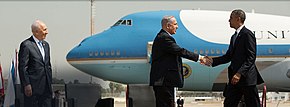
A January 2009 Pew Research Center study found that when asked "which side do you sympathize with more", 42% of Democrats and 33% of liberals (a plurality in both groups) sympathize most with the Israelis. Around half of all political moderates or independents sided with Israel.[215] The years leading up to the 2016 election have brought more discussion of the party's stance on Israel as polls reported declining support for Israel among the party faithful.[216] Gallup suggested that the decline in support might be due to tensions between Israeli Prime Minister Benjamin Netanyahu and President Barack Obama.[216]
The rise of the progressive Bernie Sanders-aligned faction of the party, which tends to trend more pro-Palestine, is also likely responsible for the decline in support for Israel. A 2016 Pew Research poll found that while Clinton supporters sympathized more with Israel than Palestinians by a 20-point margin, Sanders supporters sympathized more with Palestinians than with Israel by a 6-point margin.[217] In June 2016, DNC members voted against an amendment to the party platform proposed by Sanders supporter James Zogby calling for an "end to occupation and illegal settlements".[218] In August 2018, Rashida Tlaib, who supports a one-state solution,[219] and Ilhan Omar, who has referred to Israel as an "apartheid regime"[220] won Democratic primaries in Michigan and Minnesota. In November 2018, shortly after being elected to Congress, Omar came out in support of the Boycott, Divestment and Sanctions (BDS) campaign against Israel.[221]
Voter base
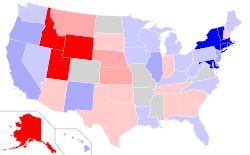
Professionals
Professionals, those who have a college education and those whose work revolves around the conception of ideas, have tended to support the Democratic Party since 2000. Between 1988 and 2000, professionals favored Democrats by a 12-percentage point margin. While the professional class was once a stronghold of the Republican Party, it has become increasingly split between the two parties, leaning in favor of the Democratic Party. The increasing support for Democratic candidates among professionals may be traced to the prevalence of social liberally values among this group:[222]
Professionals, who are, roughly speaking, college-educated producers of services and ideas, used to be the most staunchly Republican of all occupational groups [...] now chiefly working for large corporations and bureaucracies rather than on their own, and heavily influenced by the environmental, civil-rights, and feminist movements—began to vote Democratic. In the four elections from 1988 to 2000, they backed Democrats by an average of 52 percent to 40 percent.
— John B. Judis and Ruy Teixeira, The American Prospect, June 19, 2007
Academics and the highly educated constitute an important part of the Democratic voter base. In a 2005 survey, 72% of full-time faculty members identified as liberal and 15% identified as conservative.[103] Percentages of professors who identified as liberal ranged from 49% in business to over 80% in political science and the humanities.[103] The party also has strong support among scientists, with 55% identifying as Democrats, 32% as independents, and 6% as Republicans in a 2009 study.[223] Intellectualism, the tendency to constantly reexamine issues, has been named as an explanation why academia is strongly liberal.[224]
Those with graduate education have become increasingly Democratic in the 1992,[225] 1996,[225] 2000,[88] 2004,[89] and 2008[226] elections. In exit polls for the 2018 elections, 65% of those with a graduate degree said they voted Democratic.[100]
Youth
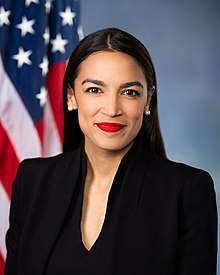
Studies have shown that younger voters tend to vote mostly for Democratic candidates in recent years. Despite supporting Ronald Reagan and George H. W. Bush, the young have voted in favor of the Democratic presidential candidate in every election since Bill Clinton in 1992 and are more likely to identify as liberals than the general population.[228] In the 2004 presidential election, Democratic presidential candidate John Kerry received 54% of the vote from voters of the age group 18–29 while Republican George W. Bush received 45% of the vote from the same age group. In the 2006 midterm elections, the Democrats received 60% of the vote from the same age group.[89][90] Polls suggest that younger voters have more liberal views than the public on same-sex marriage and universal health care, helping Barack Obama carry 66% of their votes in 2008. In the 2018 midterm elections, 67% of those in the 18–29 age range voted for the Democratic candidate.[100]
Women

Although the gender gap has varied over many years, women of all ages are more likely than men to identify as Democrats. Since the 1990s, women have supported Democratic Party candidates to various offices at higher rates than men.[229] Polls in 2009 indicated that 41% of women identify as Democrats while only 25% of women identify as Republicans and 26% as independents whereas 32% of men identify as Democrats, 28% as Republicans and 34% as independents. Among ethnic minorities, women also are more likely than men to identify as Democrats. Also, American women that identified as single, living with a domestic partner, divorced, separated, or widowed are more likely than men in these categories to vote Democratic.[230] The National Federation of Democratic Women is an affiliated organization meant to advocate for women's issues. National women's organizations that support Democratic candidates include Emily's List, which aims to help elect pro-choice female Democratic candidates to office.
Relation to marital status and parenthood
Americans that identify as single, living with a domestic partner, divorced, separated, or widowed are more likely to vote Democratic in contrast to married Americans which split about equally between Democrat and Republican.[230]
General Social Surveys of more than 11,000 Democrats and Republicans conducted between 1996 and 2006 came to the result that the differences in fertility rates are not statistically significant between these parties, with the average Democrat having 1.94 children and the average Republican having 1.91 children.[231] However, there is a significant difference in fertility rates between the two related groups liberals and conservatives, with liberals reproducing at a much lower rate than conservatives.[231]
LGBT Americans
| Year[232][233] | Candidate | Vote |
|---|---|---|
| 1996 | Bill Clinton | 71% |
| 2000 | Al Gore | 70% |
| 2004 | John Kerry | 77% |
| 2008 | Barack Obama | 70% |
| 2012 | Barack Obama | 76% |
| 2016 | Hillary Clinton | 78% |
According to exit polling, LGBT Americans typically vote Democratic in national elections within the 70–80% range. In heavily gay precincts in large cities across the nation, the average was higher, ranging from 85–94%. This trend has continued since 1996 when Bill Clinton won 71% of the LGBT vote compared to Bob Dole's 16%. In 2000 Al Gore won 70% to George W. Bush's 25%, in 2004 John Kerry won 77% to George W. Bush's 23%, in 2008 Barack Obama won 70% to John McCain's 27%, and in 2012 Barack Obama won 76% to Mitt Romney's 22%. Patrick Egan, a professor of politics at New York University specializing in LGBT voting patterns, calls this a "remarkable continuity", saying that "about three-fourths vote Democratic and one-fourth Republican from year to year".[232] Notable LGBT Democrats include Senator Tammy Baldwin of Wisconsin, Senator Kyrsten Sinema of Arizona, Representative David Cicilline of Rhode Island, and Governor Jared Polis of Colorado. The late activist and San Francisco Supervisor Harvey Milk was a Democrat as is former Representative Barney Frank of Massachusetts.
The Stonewall Democrats is an LGBT advocacy group associated with the Democratic Party. The Congressional LGBT Equality Caucus is a congressional caucus of 164 Democrats and 1 Republican that advocate for LGBT rights within the House of Representatives.[234]
Labor
Since the 1930s, a critical component of the Democratic Party coalition has been organized labor. Labor unions supply a great deal of the money, grass roots political organization and voting base of support for the party. Democrats are far more likely to be represented by unions, although union membership has declined, in general, during the last few decades. This trend is depicted in the following graph from the book Democrats and Republicans—Rhetoric and Reality.[235] It is based on surveys conducted by the National Election Studies (NES).
The historic decline in union membership over the past half-century has been accompanied by a growing disparity between public sector and private sector union membership percentages. The three most significant labor groupings in the Democratic coalition today are the AFL-CIO and Change to Win labor federations as well as the National Education Association, a large, unaffiliated teachers' union. Both the AFL-CIO and Change to Win have identified their top legislative priority for 2007 as passage of the Employee Free Choice Act. Other important issues for labor unions include supporting industrial policy (including protectionism) that sustains unionized manufacturing jobs, raising the minimum wage and promoting broad social programs such as Social Security and universal health care.
Working class
The American working class is a stronghold of the Democratic Party and continues to be an essential part of the Democratic base. Economic insecurity makes the majority of working class people left-of-center on economic issues. However, many working class Democrats differ from liberals in their more socially conservative views. Working class Democrats tend to be more religious and more likely to belong to an ethnic minority. The continued importance of the working class manifests itself in exit polls, which show that the majority of those with working class incomes and education vote for the Democratic Party.[89][90]
Since 1980,[236] there has been a decline in support for the Democratic Party among white working class voters.[237][238][239] In the 2008 presidential election, Barack Obama carried 40% of white voters without college degrees to John McCain carrying 58%.[240] In the 2012 presidential election, Obama carried 36% of white working class voters to Mitt Romney carrying 61%.[241]
African Americans
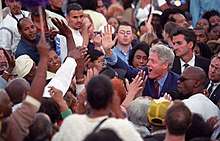
From the end of the Civil War, African Americans primarily favored the Republican Party due to its overwhelming political and more tangible efforts in achieving the abolition of slavery, particularly through President Lincoln's Emancipation Proclamation.[242] The South had long been a Democratic stronghold, favoring a state's right to legal slavery. In addition, the ranks of the fledgling Ku Klux Klan were composed almost entirely of white Democrats who were angry over the poor treatment they had received at the hands of northerners and who were also bent on reversing the policies of Reconstruction.[243] However, African Americans began drifting to the Democratic Party when Franklin D. Roosevelt was elected president.[242] Support for the Civil Rights Movement in the 1960s by Democratic presidents John F. Kennedy and Lyndon B. Johnson helped give the Democrats even greater support among the African-American community, which consistently votes between 85–95% Democratic.[242]
Prominent modern-day African-American Democratic politicians include Jim Clyburn, Elijah Cummings, Maxine Waters, John Lewis, Barbara Lee, Charles Rangel, John Conyers, Senator Cory Booker and former President Barack Obama, who managed to net over 95% of the African-American vote in the 2008 election.[244] Despite not having a partisan affiliation, the NAACP often participates in organizing and voter turnout drives and advocates for progressive causes, especially those that affect people of color.[245] Within the House of Representatives, the Congressional Black Caucus, consisting of 54 black Democrats, serves to represent the interests of African Americans and advocate on issues that affect them.[246]
Hispanic and Latino Americans

The Hispanic population, particularly the large Mexican-American population in the Southwest and the large Puerto Rican and Dominican populations in the Northeast, have been strong supporters of the Democratic Party. In the 1996 presidential election, Democratic President Bill Clinton received 72% of the Hispanic vote.[247] In following years, the Republican Party gained increasing support from the Hispanic community, especially among Hispanic Protestants and Pentecostals. With his much more liberal views on immigration, President Bush was the first Republican president to gain 40% of the Hispanic vote in the 2004 presidential election. But the Republican Party's support among Hispanics eroded in the 2006 midterm elections, dropping from 44% to 30%, with the Democrats gaining in the Hispanic vote from 55% in 2004 to 69% in 2006.[89][90] Democrats increased their share of the Hispanic vote in the 2008 presidential election, with Barack Obama receiving 67%. According to exit polls by Edison Research, Obama increased his support again in 2012, winning 71% of Hispanic voters.[248]
Cuban Americans still tend to vote Republican, though there has been a noticeable change starting with the 2008 elections. During the 2008 elections, Barack Obama received 47% of the Cuban-American vote in Florida.[249] According to Bendixen's exit polls, 84% of Miami-Dade Cuban-American voters 65 or older backed McCain, while 55% of those 29 or younger backed Obama,[250] showing that the younger Cuban-American generation has become more liberal.
Unaffiliated Hispanic advocacy groups that often support progressive candidates and causes include the National Council of La Raza and the League of United Latin American Citizens. In the House of Representatives, the Democratic caucus of Hispanic Americans is the Congressional Hispanic Caucus.
In the 2018 elections, 69% of Latino Americans voted for the Democratic House candidate.[100]
Asian Americans
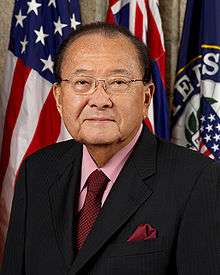
The Democratic Party has considerable support in the small yet growing Asian-American population. Asian Americans had been a stronghold of the Republican Party up to and including the 1992 presidential election, in which George H. W. Bush won 55% of the Asian-American vote. Originally, the vast majority of Asian Americans were strongly anti-communist Vietnamese refugees, Chinese Americans, Taiwanese Americans, Korean Americans, and Filipino Americans, and the Republican Party's positions resonated with this demographic. The Democratic Party made gains among Asian Americans starting in 1996 and in 2006 won 62% of the Asian-American vote. Exit polls after the 2008 presidential election indicated that Democratic candidate, Barack Obama, won 62% of the Asian-American vote.[251] In the 2012 presidential election, 73% of the Asian-American electorate voted for Obama's re-election.[252]
Barack Obama had the support of 85% of Indian Americans, 68% of Chinese Americans, and 57% of Filipino Americans.[253] The Asian-American community's increasing number of young voters has also helped to erode traditionally reliably Republican voting blocs such as Vietnamese and Filipino Americans, leading to an increase in support for Democrats. Prominent Asian-American Democrats include Senators Tammy Duckworth, Daniel Inouye, Daniel Akaka, and Mazie Hirono, former Governor and Secretary of Commerce Gary Locke, and Representatives Mike Honda, Judy Chu, Doris Matsui, and Norman Mineta.
In the 2018 elections, 77% of Asian Americans voted for the Democratic candidate.[100]
Native Americans
The Democratic Party also has strong support among the Native American population, particularly in Arizona, New Mexico, Montana, North Dakota, South Dakota, Washington, Alaska, Idaho, Minnesota, Wisconsin, Oklahoma,[254] and North Carolina. Although now a small percentage of the population (virtually non-existent in some regions), most Native American precincts vote Democratic in margins exceeded only by African Americans.[255]
Modern-day Democratic Native American politicians include former Congressman Brad Carson of Oklahoma as well as Principal Chief Bill John Baker of the Cherokee Nation and Governor Bill Anoatubby of the Chickasaw Nation.
In 2018, Democrats Deb Haaland of New Mexico and Sharice Davids of Kansas became the first Native American women ever elected to Congress.[256] Democrat Peggy Flanagan was also elected in 2018 and currently serves as Lieutenant Governor of Minnesota. Flanagan is the second Native American woman to be elected to statewide executive office in U.S. history and the highest-ranking Native woman to be elected to executive office.[257]
Jewish Americans

Jewish American communities tend to be a stronghold for the Democratic Party, with more than 70% of Jewish voters having cast their ballots for the Democrats in the 2004 and 2006 elections.[89][90] Al Gore received 79% of the Jewish votes in 2000, and Barack Obama won about 77% of the Jewish vote in 2008.[258] Support tends to vary among specific sectarian groups. For example, only 13% of Orthodox Jews supported Barack Obama in 2008 while around 60% of Conservative Jews and Reform Jews did so.[259] In the 2018 House of Representatives elections, 79% of Jewish Americans voted for the Democratic candidate.[100]
Jews as an important Democratic constituency are especially politically active and influential in large cities such as New York City, Los Angeles, Boston and Chicago and play critical roles in large cities within presidential swing states, such as Philadelphia, Miami and Las Vegas. Many prominent national Democrats in recent decades have been Jewish, including Chuck Schumer, Carl Levin, Abraham Ribicoff, Ben Cardin, Henry Waxman, Martin Frost, Joseph Lieberman, Bernie Sanders, Dianne Feinstein, Barney Frank, Barbara Boxer, Paul Wellstone, Rahm Emanuel, Russ Feingold, Herb Kohl and Howard Metzenbaum.[259]
Arab and Muslim Americans
Arab Americans and Muslim Americans have leaned Democratic since the Iraq War.[260] Zogby found in June 2007 that 39% of Arab Americans identify as Democrats, 26% as Republicans and 28% as independents.[260]
Arab Americans, who are in general socially conservative yet with more diverse economic views, historically voted Republican until recent years, having supported George W. Bush over Al Gore in 2000.[261]
A 2012 poll found that 68% of Muslim Americans surveyed support Barack Obama.[262]
Secular Americans
The Democratic Party receives support from secular organizations such as the Secular Coalition for America[263] and many agnostic and atheist Americans. Exit polls from the 2008 election showed that voters with a religious affiliation of "none" accounted for the 12% of the electorate and voted for Obama by a 75–25% margin.[264] In his first inaugural address, Obama acknowledged atheists by saying that the United States is not just "Christians and Muslims, Jews and Hindus but non-believers as well".[265] In the 2012 election cycle, Obama had moderate to high ratings with the Secular Coalition for America while the majority of the Republican candidates had ratings in the low-to-failing range.[266]
Democratic presidents
As of 2019, there have been a total of 15 Democratic Party presidents.
| # | Name | Portrait | State | Presidency start date |
Presidency end date |
Time in office |
|---|---|---|---|---|---|---|
| 7 | Andrew Jackson | 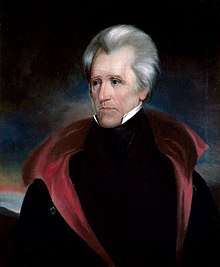 |
Tennessee | March 4, 1829 | March 4, 1837 | 8 years, 0 days |
| 8 | Martin Van Buren | .jpg) |
New York | March 4, 1837 | March 4, 1841 | 4 years, 0 days |
| 11 | James K. Polk | Tennessee | March 4, 1845 | March 4, 1849 | 4 years, 0 days | |
| 14 | Franklin Pierce |  |
New Hampshire | March 4, 1853 | March 4, 1857 | 4 years, 0 days |
| 15 | James Buchanan | 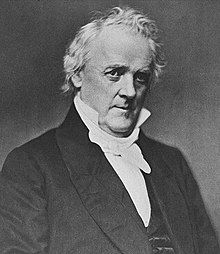 |
Pennsylvania | March 4, 1857 | March 4, 1861 | 4 years, 0 days |
| 17 | Andrew Johnson |  |
Tennessee | April 15, 1865 | March 4, 1869 | 3 years, 323 days |
| 22 | Grover Cleveland | .jpg) |
New York | March 4, 1885 | March 4, 1889 | 8 years, 0 days |
| 24 | March 4, 1893 | March 4, 1897 | ||||
| 28 | Woodrow Wilson |  |
New Jersey | March 4, 1913 | March 4, 1921 | 8 years, 0 days |
| 32 | Franklin D. Roosevelt | .jpg) |
New York | March 4, 1933 | April 12, 1945[lower-alpha 1] | 12 years, 39 days |
| 33 | Harry S. Truman | 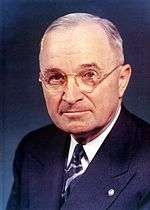 |
Missouri | April 12, 1945 | January 20, 1953 | 7 years, 283 days |
| 35 | John F. Kennedy |  |
Massachusetts | January 20, 1961 | November 22, 1963[lower-alpha 1] | 2 years, 306 days |
| 36 | Lyndon B. Johnson |  |
Texas | November 22, 1963 | January 20, 1969 | 5 years, 59 days |
| 39 | Jimmy Carter |  |
Georgia | January 20, 1977 | January 20, 1981 | 4 years, 0 days |
| 42 | Bill Clinton |  |
Arkansas | January 20, 1993 | January 20, 2001 | 8 years, 0 days |
| 44 | Barack Obama | .jpg) |
Illinois | January 20, 2009 | January 20, 2017 | 8 years, 0 days |
Supreme Court justices appointed by Democratic presidents
In the Supreme Court, as of May 2020, four of the nine seats are filled by justices appointed by Democratic presidents.[267]
Recent electoral history
In congressional elections: 1950–present
| House of Representatives | President | Senate | ||||||
|---|---|---|---|---|---|---|---|---|
| Election
year |
No. of
seats won |
+/– | No. of
seats won |
+/– | Election
year | |||
| 1950 | 235 / 435 |
Harry S. Truman | 49 / 96 |
1950 | ||||
| 1952 | 213 / 435 |
Dwight D. Eisenhower | 47 / 96 |
1952 | ||||
| 1954 | 232 / 435 |
49 / 96 |
1954 | |||||
| 1956 | 234 / 435 |
49 / 96 |
1956 | |||||
| 1958 | 283 / 435 |
64 / 98 |
1958 | |||||
| 1960 | 262 / 435 |
John F. Kennedy | 64 / 100 |
1960 | ||||
| 1962 | 258 / 435 |
66 / 100 |
1962 | |||||
| 1964 | 295 / 435 |
Lyndon B. Johnson | 68 / 100 |
1964 | ||||
| 1966 | 248 / 435 |
64 / 100 |
1966 | |||||
| 1968 | 243 / 435 |
Richard Nixon | 57 / 100 |
1968 | ||||
| 1970 | 255 / 435 |
54 / 100 |
1970 | |||||
| 1972 | 242 / 435 |
56 / 100 |
1972 | |||||
| 1974 | 291 / 435 |
Gerald Ford | 60 / 100 |
1974 | ||||
| 1976 | 292 / 435 |
Jimmy Carter | 61 / 100 |
1976 | ||||
| 1978 | 277 / 435 |
58 / 100 |
1978 | |||||
| 1980 | 243 / 435 |
Ronald Reagan | 46 / 100 |
1980 | ||||
| 1982 | 269 / 435 |
46 / 100 |
1982 | |||||
| 1984 | 253 / 435 |
47 / 100 |
1984 | |||||
| 1986 | 258 / 435 |
55 / 100 |
1986 | |||||
| 1988 | 260 / 435 |
George H.W. Bush | 55 / 100 |
1988 | ||||
| 1990 | 267 / 435 |
56 / 100 |
1990 | |||||
| 1992 | 258 / 435 |
Bill Clinton | 57 / 100 |
1992 | ||||
| 1994 | 204 / 435 |
47 / 100 |
1994 | |||||
| 1996 | 206 / 435 |
45 / 100 |
1996 | |||||
| 1998 | 211 / 435 |
45 / 100 |
1998 | |||||
| 2000 | 212 / 435 |
George W. Bush | 50 / 100 |
2000 | ||||
| 2002 | 204 / 435 |
49 / 100 |
2002 | |||||
| 2004 | 202 / 435 |
45 / 100 |
2004 | |||||
| 2006 | 233 / 435 |
51 / 100 |
2006 | |||||
| 2008 | 257 / 435 |
Barack Obama | 59 / 100 |
2008 | ||||
| 2010 | 193 / 435 |
53 / 100 |
2010 | |||||
| 2012 | 201 / 435 |
55 / 100 |
2012 | |||||
| 2014 | 188 / 435 |
46 / 100 |
2014 | |||||
| 2016 | 194 / 435 |
Donald Trump | 48 / 100 |
2016 | ||||
| 2018 | 235 / 435 |
47 / 100 |
2018 | |||||
In presidential elections: 1828–present
| Election year |
Candidates | Votes | Vote % | Electoral votes | +/– | Result |
|---|---|---|---|---|---|---|
| 1828 | Andrew Jackson | 642,553 | 56.0 | 178 / 261 |
Won | |
| 1832 | Andrew Jackson | 701,780 | 54.2 | 219 / 286 |
Won | |
| 1836 | Martin Van Buren | 764,176 | 50.8 | 170 / 294 |
Won | |
| 1840 | Martin Van Buren | 1,128,854 | 46.8 | 60 / 294 |
Lost | |
| 1844 | James K. Polk | 1,339,494 | 49.5 | 170 / 275 |
Won | |
| 1848 | Lewis Cass | 1,223,460 | 42.5 | 127 / 290 |
Lost | |
| 1852 | Franklin Pierce | 1,607,510 | 50.8 | 254 / 296 |
Won | |
| 1856 | James Buchanan | 1,836,072 | 45.3 | 174 / 296 |
Won | |
| 1860 | Stephen A. Douglas | 1,380,202 | 29.5 | 12 / 303 |
Lost | |
| 1864 | George B. McClellan | 1,812,807 | 45.0 | 21 / 233 |
Lost | |
| 1868 | Horatio Seymour | 2,706,829 | 47.3 | 80 / 294 |
Lost | |
| 1872 | Horace Greeley (Liberal Republican) | 2,834,761 | 43.8 | 69 / 352 |
Lost | |
| 1876 | Samuel J. Tilden | 4,288,546 | 50.9 | 184 / 369 |
Lost[upper-alpha 1] | |
| 1880 | Winfield Scott Hancock | 4,444,260 | 48.2 | 155 / 369 |
Lost | |
| 1884 | Grover Cleveland | 4,914,482 | 48.9 | 219 / 401 |
Won | |
| 1888 | Grover Cleveland | 5,534,488 | 48.6 | 168 / 401 |
Lost[upper-alpha 2] | |
| 1892 | Grover Cleveland | 5,556,918 | 46.0 | 277 / 444 |
Won | |
| 1896 | William Jennings Bryan | 6,509,052 | 46.7 | 176 / 447 |
Lost | |
| 1900 | William Jennings Bryan | 6,370,932 | 45.5 | 155 / 447 |
Lost | |
| 1904 | Alton B. Parker | 5,083,880 | 37.6 | 140 / 476 |
Lost | |
| 1908 | William Jennings Bryan | 6,408,984 | 43.0 | 162 / 483 |
Lost | |
| 1912 | Woodrow Wilson | 6,296,284 | 41.8 | 435 / 531 |
Won | |
| 1916 | Woodrow Wilson | 9,126,868 | 49.2 | 277 / 531 |
Won | |
| 1920 | James M. Cox | 9,139,661 | 34.2 | 127 / 531 |
Lost | |
| 1924 | John W. Davis | 8,386,242 | 28.8 | 136 / 531 |
Lost | |
| 1928 | Al Smith | 15,015,464 | 40.8 | 87 / 531 |
Lost | |
| 1932 | Franklin D. Roosevelt | 22,821,277 | 57.4 | 472 / 531 |
Won | |
| 1936 | Franklin D. Roosevelt | 27,747,636 | 60.8 | 523 / 531 |
Won | |
| 1940 | Franklin D. Roosevelt | 27,313,945 | 54.7 | 449 / 531 |
Won | |
| 1944 | Franklin D. Roosevelt | 25,612,916 | 53.4 | 432 / 531 |
Won | |
| 1948 | Harry S. Truman | 24,179,347 | 49.6 | 303 / 531 |
Won | |
| 1952 | Adlai Stevenson | 27,375,090 | 44.3 | 89 / 531 |
Lost | |
| 1956 | Adlai Stevenson | 26,028,028 | 42.0 | 73 / 531 |
Lost | |
| 1960 | John F. Kennedy | 34,220,984 | 49.7 | 303 / 537 |
Won | |
| 1964 | Lyndon B. Johnson | 43,127,041 | 61.1 | 486 / 538 |
Won | |
| 1968 | Hubert Humphrey | 31,271,839 | 42.7 | 191 / 538 |
Lost | |
| 1972 | George McGovern | 29,173,222 | 37.5 | 17 / 538 |
Lost | |
| 1976 | Jimmy Carter | 40,831,881 | 50.1 | 297 / 538 |
Won | |
| 1980 | Jimmy Carter | 35,480,115 | 41.0 | 49 / 538 |
Lost | |
| 1984 | Walter Mondale | 37,577,352 | 40.6 | 13 / 538 |
Lost | |
| 1988 | Michael Dukakis | 41,809,074 | 45.6 | 111 / 538 |
Lost | |
| 1992 | Bill Clinton | 44,909,806 | 43.0 | 370 / 538 |
Won | |
| 1996 | Bill Clinton | 47,401,185 | 49.2 | 379 / 538 |
Won | |
| 2000 | Al Gore | 50,999,897 | 48.4 | 266 / 538 |
Lost[upper-alpha 3] | |
| 2004 | John Kerry | 59,028,444 | 48.3 | 251 / 538 |
Lost | |
| 2008 | Barack Obama | 69,498,516 | 52.9 | 365 / 538 |
Won | |
| 2012 | Barack Obama | 65,915,795 | 51.1 | 332 / 538 |
Won | |
| 2016 | Hillary Clinton | 65,853,514 | 48.2 | 227 / 538 |
Lost[upper-alpha 4] | |
| 2020 | Joe Biden (presumptive) | TBD | TBD | TBD | TBD | TBD |
See also
Notes
- Died in office.
- Vice President Dick Cheney provided tie-breaking vote, giving Republicans a majority
- Includes two independents caucusing with the Democrats.
- Although Tilden won a majority of the popular vote, Republican Rutherford B. Hayes won a majority of votes in the Electoral College.
- Although Cleveland won a plurality of the popular vote, Republican Benjamin Harrison won a majority of votes in the Electoral College.
- Although Gore won a plurality of the popular vote, Republican George W. Bush won a majority of votes in the Electoral College.
- Although Clinton won a plurality of the popular vote, Republican Donald Trump won a majority of votes in the Electoral College.
References
- Donald B. Cole (1970). Jacksonian Democracy in New Hampshire. Harvard University Press. p. 69.
- Winger, Richard. "March 2020 Ballot Access News Print Edition". Ballot Access News. Retrieved April 5, 2020.
- Arnold, N. Scott (2009). Imposing values: an essay on liberalism and regulation. Florence: Oxford University Press. p. 3. ISBN 978-0-495-50112-1.
Modern liberalism occupies the left-of-center in the traditional political spectrum and is represented by the Democratic Party in the United States.
- "President Obama, the Democratic Party, and Socialism: A Political Science Perspective". The Huffington Post. June 29, 2012. Retrieved January 9, 2015.
- Paul Starr. "Center-Left Liberalism". Princeton University. Archived from the original on March 3, 2015. Retrieved June 9, 2014.
- Hale, John (1995). The Making of the New Democrats. New York: Political Science Quarterly. p. 229.
- Dewan, Shaila; Kornblut, Anne E. (October 30, 2006). "In Key House Races, Democrats Run to the Right". The New York Times. Retrieved January 28, 2017.
- Joe Manchin (October 9, 2010). "Dead Aim - Joe Manchin for West Virginia TV Ad" – via YouTube.
- Etzioni, Amitai (January 8, 2015). "The Left's Unpopular Populism". The Atlantic. Retrieved March 25, 2017.
- Ball, Molly. "The Battle Within the Democratic Party". The Atlantic. Archived from the original on June 12, 2018. Retrieved January 28, 2017.
- Raza, Syed Ali (2012), Social Democratic System, Global Peace Trust, p. 91
- "The Democratic Party, founded in 1828, is the world's oldest political party" states Kenneth Janda; Jeffrey M. Berry; Jerry Goldman (2010). The Challenge of Democracy: American Government in Global Politics. Cengage Learning. p. 276. ISBN 9780495906186.
- Grigsby, Ellen (2008). Analyzing Politics: An Introduction to Political Science. Florence: Cengage Learning. pp. 106–107. ISBN 978-0-495-50112-1.
In the United States, the Democratic Party represents itself as the liberal alternative to the Republicans, but its liberalism is for the most part the later version of liberalism—modern liberalism.
- Prendergast, William B. (1999). The Catholic Voter in American Politics. The Passing of the Democratic Monolith. Washington, D.C.: Georgetown University. ISBN 978-0-87840-724-8.
- Marlin, George J. (2004). The American Catholic Voter. 200 Years of Political Impact. South Bend, Indiana: St. Augustine. ISBN 978-1-58731-029-4.
- Michael Corbett et al. Politics and Religion in the United States (2nd ed. 2013).
- "1. Trends in party affiliation among demographic groups". Pew Research Center. March 20, 2018. Retrieved December 29, 2018.
- "How Asian Americans Became Democrats". The American Prospect. Retrieved October 22, 2016.
- Brownstein, Ronald (May 21, 2019). "The Democratic Party is being transformed. These House votes show how". CNN. Retrieved May 22, 2019.
- Larry E. Sullivan. The SAGE glossary of the social and behavioral sciences (2009) p 291, "This liberalism favors a generous welfare state and a greater measure of social and economic equality. Liberty thus exists when all citizens have access to basic necessities such as education, healthcare, and economic opportunities."
- Levy, Jonah (2006). The State after Statism: New State Activities in the Age of Liberalization. Florence: Harvard University Press. p. 198. ISBN 978-0-495-50112-1.
In the corporate governance area, the center-left repositioned itself to press for reform. The Democratic Party in the United States used the postbubble scandals and the collapse of share prices to attack the Republican Party ... Corporate governance reform fit surprisingly well within the contours of the center-left ideology. The Democratic Party and the SPD have both been committed to the development of the regulatory state as a counterweight to managerial authority, corporate power, and market failure.
- U.S. Department of State. "A Mixed Economy: The Role of the Market". About.com. Archived from the original on January 18, 2017.
- "Democratic Party on Government Reform". Ontheissues.org. Retrieved January 19, 2015.
- "Democratic Platform Endorses Gay Marriage". All Things Considered. Npr.org. September 4, 2012. Retrieved October 2, 2013.
- Chammah, Maurice (July 18, 2016). "Two Parties, Two Platforms on Criminal Justice". The Marshall Project. Retrieved May 22, 2019.
- "Preventing Gun Violence". Democrats.org. Archived from the original on November 4, 2018. Retrieved May 22, 2019.
- "Democratic Party on Abortion". OnTheIssues.org. Retrieved August 5, 2020.
- "The 2016 Democratic Platform". Democrats.org. Archived from the original on September 27, 2018. Retrieved May 22, 2019.
- "State government trifectas". Ballotpedia. Retrieved January 13, 2018.
- Thompson, Derek. "How Democrats Conquered the City". The Atlantic. Retrieved March 13, 2020.
- Arthur Paulson, Realignment and Party Revival: Understanding American Electoral Politics at the Turn of the Twenty-First Century (2000) pp. 46–72.
- James Roger Sharp, American Politics in the Early Republic: The New Nation in Crisis (1993).
- Traub, James. "The Ugly Election That Birthed Modern American Politics". National Geographic. Retrieved July 6, 2018.
- Mary Beth Norton et al., A People and a Nation, Volume I: to 1877 (Houghton Mifflin, 2007) p. 287.
- Mary Beth Norton et al., A People and a Nation, Volume I: to 1877 (2007) pp. 287–288.
- Galbraith Schlisinger, Of the People: The 200 Year History of the Democratic Party (1992) ch. 1–3.
- Robert Allen Rutland, The Democrats: From Jefferson to Clinton (U. of Missouri Press, 1995) ch. 1–4.
- Jean H. Baker, Affairs of Party: Political Culture of Northern Democrats in the Mid-nineteenth Century (1983)
- David M. Potter. The Impending Crisis, 1848–1861 (1976). ch. 16.
- Mark E. Neely. Lincoln and the Democrats: The Politics of Opposition in the Civil War (2017).
- Rutland, The Democrats: From Jefferson to Clinton (1995) ch. 5–6.
- Robert W. Cherny, A Righteous Cause: The Life of William Jennings Bryan (1994)
- H.W. Brands, Woodrow Wilson (2003).
- Douglas B. Craig, After Wilson: The Struggle for the Democratic Party, 1920-1934 (1993)
- Ellen Russell (2007). New Deal Banking Reforms and Keynesian Welfare State Capitalism. Routledge. pp. 3–4. ISBN 9781135910655.
- Rutland, The Democrats: From Jefferson to Clinton (1995) ch. 7.
- David M. Kennedy, Freedom from Fear: The American People in Depression and War, 1929-1945 (2001).
- Paul Finkelman and Peter Wallenstein, eds. The Encyclopedia Of American Political History (CQ Press, 2001) pp. 124–126.
- "Race, Campaign Politics, and the Realignment in the South". yalebooks.yale.edu. Retrieved June 9, 2018.
- Bullock, Charles S.; Hoffman, Donna R.; Gaddie, Ronald Keith (2006). "Regional Variations in the Realignment of American Politics, 1944–2004". Social Science Quarterly. 87 (3): 494–518. doi:10.1111/j.1540-6237.2006.00393.x. ISSN 0038-4941.
The events of 1964 laid open the divisions between the South and national Democrats and elicited distinctly different voter behavior in the two regions. The agitation for civil rights by southern blacks continued white violence toward the civil rights movement, and President Lyndon Johnson's aggressive leadership all facilitated passage of the 1964 Civil Rights Act. [...] In the South, 1964 should be associated with GOP growth while in the Northeast this election contributed to the eradication of Republicans.
- Gaddie, Ronald Keith (February 17, 2012). "Realignment". Oxford Handbooks Online. doi:10.1093/oxfordhb/9780195381948.013.0013. Retrieved June 9, 2018.
- Stanley, Harold W. (1988). "Southern Partisan Changes: Dealignment, Realignment or Both?". The Journal of Politics. 50 (1): 64–88. doi:10.2307/2131041. ISSN 0022-3816. JSTOR 2131041.
Events surrounding the presidential election of 1964 marked a watershed in terms of the parties and the South (Pomper, 1972). The Solid South was built around the identification of the Democratic party with the cause of white supremacy. Events before 1964 gave white southerners pause about the linkage between the Democratic Party and white supremacy, but the 1964 election, passage of the Civil Rights Act of 1964, and the Voting Rights Act of 1965 altered in the minds of most the positions of the national parties on racial issues.
- Miller, Gary; Schofield, Norman (2008). "The Transformation of the Republican and Democratic Party Coalitions in the U.S.". Perspectives on Politics. 6 (3): 433–50. doi:10.1017/S1537592708081218. ISSN 1541-0986.
1964 was the last presidential election in which the Democrats earned more than 50 percent of the white vote in the United States.
- "The Rise of Southern Republicans – Earl Black, Merle Black". hup.harvard.edu. Harvard University Press. Retrieved June 9, 2018.
When the Republican party nominated Arizona Senator Barry Goldwater—one of the few senators who had opposed the Civil Rights Act—as their presidential candidate in 1964, the party attracted many southern whites but permanently alienated African-American voters. Beginning with the Goldwater-versus-Johnson campaign more southern whites voted Republican than Democratic, a pattern that has recurred in every subsequent presidential election. [...] Before the 1964 presidential election the Republican party had not carried any Deep South state for eighty-eight years. Yet shortly after Congress passed the Civil Rights Act, hundreds of Deep South counties gave Barry Goldwater landslide majorities.
- "Issue Evolution". Princeton University Press. Retrieved June 9, 2018.
- Miller, Gary; Schofield, Norman (2003). "Activists and Partisan Realignment in the United States". American Political Science Review. 97 (2): 245–60. doi:10.1017/S0003055403000650. ISSN 1537-5943.
By 2000, however, the New Deal party alignment no longer captured patterns of partisan voting. In the intervening 40 years, the Civil Rights and Voting Rights Acts had triggered an increasingly race-driven distinction between the parties. [...] Goldwater won the electoral votes of five states of the Deep South in 1964, four of the states that had voted Democratic for 84 years (Califano 1991, 55). He forged a new identification of the Republican party with racial conservatism, reversing a century-long association of the GOP with racial liberalism. This, in turn, opened the door for Nixon's "Southern strategy" and the Reagan victories of the eighties.
- Valentino, Nicholas A.; Sears, David O. (2005). "Old Times There Are Not Forgotten: Race and Partisan Realignment in the Contemporary South". American Journal of Political Science. 49 (3): 672–88. doi:10.1111/j.1540-5907.2005.00136.x. ISSN 0092-5853.
- Kuziemko, Ilyana; Washington, Ebonya (2018). "Why Did the Democrats Lose the South? Bringing New Data to an Old Debate". American Economic Review. 108 (10): 2830–2867. doi:10.1257/aer.20161413. ISSN 0002-8282.
- James T. Patterson, Grand Expectations: The United States, 1945-1974 (1997).
- Patterson, Grand Expectations: The United States, 1945-1974 (1997).
- James T. Patterson, Restless Giant: The United States from Watergate to Bush v. Gore (2011).
- Patterson. Restless Giant: The United States from Watergate to Bush v. Gore (2011).
- Rutland, The Democrats: From Jefferson to Clinton (1995) ch 8
- York, David Smith Molly Redden in New (April 1, 2016). "Donald Trump's abortion remarks provoke biggest crisis of his campaign". The Guardian. ISSN 0261-3077. Retrieved June 29, 2020.
- McCormick, Stephanie Armour and John (March 14, 2020). "Democrats Sharpen Criticism of Trump's Health-Care Policy in Coronavirus Pandemic". Wall Street Journal. ISSN 0099-9660. Retrieved June 29, 2020.
- "Trump WHO decision draws criticism from Democrats in US Congress". www.aljazeera.com. Retrieved June 29, 2020.
- "Partisan Polarization Surges in Bush, Obama Years". U.S. Politics & Policy. Pew Research Center. June 4, 2012. Retrieved February 13, 2015.
- "Party Affiliation | Gallup Historical Trends". Gallup.com. Retrieved March 18, 2014.
- E. J. Dionne, July 15, 2018, Washington Post, Does the blue wave start in Jersey?, Retrieved July 16, 2018
- Appleby, Joyce (2003). Thomas Jefferson. p. 4. ISBN 978-0-521-64841-7.
- "Democratic Party". Encyclopædia Britannica. Retrieved January 19, 2015.
- see "History of the Democratic Donkey"
- John William Ward (1962). Andrew Jackson: Symbol for an Age. Oxford Up. pp. 87–88. ISBN 9780199923205.
- "Barbour County, West Virginia General Election Ballot" (PDF). November 4, 2008. Archived from the original (PDF) on October 24, 2008.
- Seidman, Steven (June 12, 2010). "The Rooster as the Symbol of the U.S. Democratic Party". Ithaca College. Archived from the original on October 24, 2017.
- Lopez, Tomas (October 23, 2014). "Poor Ballot Design Hurts New York's Minor Parties ... Again". Brennan Center for Justice.
- Farhi, Paul (November 2, 2004). "Elephants Are Red, Donkeys Are Blue". Washington Post. p. C01. Archived from the original on May 9, 2008. Retrieved October 11, 2016.
- Trotter, Bill (February 11, 2008). "Obama sets sights on November battle". Bangor Daily News. Archived from the original on February 28, 2008. Retrieved February 12, 2008.
- Gruss, Michael (November 21, 2006). "Local roast becomes political pep rally for Democrats". The Virginian-Pilot. Retrieved April 15, 2007.
- Scherer, Michael (November 8, 2006). "The Democrats are ready to lead". Salon.com. Retrieved March 18, 2007.
- "New Sanders Ad Uses Simon & Garfunkel Classic 'America'". NBC News. January 21, 2016. Retrieved January 21, 2016.
- Corasaniti, Nick (January 23, 2016). "No Split Between Simon and Garfunkel Over Bernie Sanders's Use of Their Song". The New York Times. Retrieved January 26, 2016.
- Przybyla, Heidi (February 25, 2017). "Democrats elect Tom Perez, former Labor secretary, as new party leader". USA Today.
- Gilgoff, Dan (July 16, 2006). "Dean's List". U.S. News & World Report. Archived from the original on July 8, 2012. Retrieved April 26, 2007.
- "Democratic Governors Elect Governor Gina Raimondo as Next DGA Chair". Democratic Governors Association. December 1, 2018. Retrieved April 28, 2020.
- "Home". National Conference of Democratic Mayors. Retrieved March 21, 2020.
- John Ashworth, "Agrarians" & "aristocrats": Party political ideology in the United States, 1837–1846(1983)
- "CNN. (2000). Exit Poll". Archived from the original on June 30, 2007. Retrieved July 11, 2007.
- "CNN. (2004). Exit Poll". Retrieved July 11, 2007.
- "CNN. (2006). Exit Poll". Retrieved July 11, 2007.
- Brownstein, Ronald. "The Democrats' Coalition Could Fundamentally Change by 2020". The Atlantic. Retrieved March 13, 2020.
- "About Us - New Democrat Coalition". Archived from the original on March 5, 2016.
- "How the DLC Does It", Robert Dreyfuss, American Prospect, April 23, 2001.
- "Members - New Democrat Coalition". Archived from the original on September 7, 2016.
- Hale, Jon F. (January 1, 1995). "The Making of the New Democrats". Political Science Quarterly. 110 (2): 207–232. doi:10.2307/2152360. JSTOR 2152360.
- "NDN - A Progressive Think Tank and Advocacy Organization".
- "Senate New Democrat Coalition Members". Archive.org. August 26, 2002. Archived from the original on August 26, 2002. Retrieved April 16, 2017.CS1 maint: BOT: original-url status unknown (link)
- "Obama: 'I am a New Democrat'". Politico.com. Retrieved April 16, 2017.
- Roger Chapman, Culture Wars: An Encyclopedia (2010) vol 1 Page 136
- "Exit Polls". CNN Politics. Retrieved July 4, 2020.
- Judis, John B. (July 11, 2003). "The trouble with Howard Dean". Salon. Salon.com. Archived from the original on July 8, 2012. Retrieved July 19, 2007.
- "Pew Research Center. (May 10, 2005). Beyond Red vs. Blue, p. 1 of 8". May 10, 2005. Archived from the original on July 8, 2012. Retrieved July 12, 2007.
- Kurtz, Howard (March 29, 2005). "College Faculties A Most Liberal Lot, Study Finds". The Washington Post. Washingtonpost.com. Archived from the original on July 8, 2012. Retrieved July 2, 2007.
- "Progressivism". Columbia Encyclopaedia. 2007. Archived from the original on June 29, 2008. Retrieved January 19, 2015.
- "Important Examples of Progressive Reforms". University of MIchigan.
- Sirotam David (May 25, 2011). "What's the Difference Between a Liberal and a Progressive?". Huffington Post. Retrieved March 18, 2014.
- "Elizabeth Warren's 11 Commandments of Progressivism". National Journal.
- "Issues". Pdacommunity.org. Archived from the original on February 23, 2014. Retrieved March 18, 2014.
- "The Invisible Primary Against Hillary Clinton". National Journal. February 3, 2014.
- McPherson, Lindsey (November 29, 2018). "Jayapal Joins Pocan As Co-Chair of Congressional Progressive Caucus". rollcall.com. Retrieved January 20, 2019.
- "Caucus Members". Congressional Progressive Caucus. Retrieved March 21, 2020.
- Sargent, Greg (March 13, 2014). "Push to expand Social Security (not cut it) gets another boost". Washington Post.
- Mufson, Steven (January 2015). "Obama's budget proposal will take aim at the wealthy". Washingtonpost.com.
- "On The Issues : Every Issue - Every Politician". Ontheissues.org. Retrieved January 19, 2015.
- Bacon, Perry, Jr. (May 28, 2019). "What Republicans And Democrats Are Doing In The States Where They Have Total Power". FiveThirtyEight. Retrieved June 5, 2019.
- "Education". Democrats.org.
- "Health Care". Democrats.org. Archived from the original on May 30, 2014. Retrieved May 29, 2014.
- "Democratic Party Platform 2016" (PDF). Archived from the original (PDF) on November 10, 2016. Retrieved November 11, 2016.
- "Science & Technology". Democrats.org. Archived from the original on June 26, 2014. Retrieved May 29, 2014.
- Meg Handley. "6 Energy Policy Highlights from the Democratic Party Platform". US News & World Report.
- Zack Colman (March 12, 2013). "Democrats circulate carbon tax bill". TheHill.
- "THE ALLIANCE OF U.S. LABOR UNIONS AND THE DEMOCRATIC PARTY" (PDF). Scholarsstrategynetwork.org. Retrieved January 19, 2015.
- "Worker Rights". Archived from the original on August 21, 2014.
- Asma Khalid (June 9, 2014). "Obama Endorses Sen. Warren's Student Loan Refinancing Bill". wbur.
- Green, Erica. "House Democrats Unveil Plan to Make College More Affordable". The New York Times. Retrieved March 21, 2020.
- "Democrats highlight equal pay in political push". CNN. April 7, 2014.
- Wyatt, Edward (November 10, 2014). "Obama Net Neutrality". The New York Times. Retrieved January 19, 2015.
- "A Call for Election Reform, Beginning with New York". The Huffington Post. June 15, 2013.
- "Voting Rights". Democrats.org. Archived from the original on February 9, 2014. Retrieved February 2, 2014.
- "For Torture and Surveillance Commission via H.R. 104, Target The Congressional Progressive Caucus". Irregular Times. Archived from the original on May 29, 2014. Retrieved May 29, 2014.
- "Democratic Party on Crime". Ontheissues.org. Retrieved January 19, 2015.
- "Jobs and the Economy". Democrats.org. Archived from the original on March 20, 2015. Retrieved July 14, 2014.
- Dan Roberts (April 19, 2014). "Wall Street deregulation pushed by Clinton advisers, documents reveal". the Guardian.
- Mudge, Stephanie (2018). Leftism Reinvented: Western Parties from Socialism to Neoliberalism. Cambridge, Massachusetts: Harvard University Press. pp. 167–213.
- "How High Should Taxes Be?". Economics.about.com. June 12, 2010. Retrieved June 17, 2010.
- "The Wall Street Journal Online". Opinionjournal.com. November 17, 2007. Retrieved June 17, 2010.
- Cox, Wendell. "Budget Resolution Calls for Massive Tax Hikes and Spending Increases". Heritage.org. Archived from the original on March 12, 2010. Retrieved June 17, 2010.
- "The Social Safety Net". usinfo.state.gov. Archived from the original on April 10, 2008.
- "Day Two: House passes new budget rules". Associated Press. January 5, 2007. Retrieved January 5, 2007.
- "The Democratic Party Platform". Democrats.org. Archived from the original on March 15, 2014. Retrieved March 18, 2014.
- Kulwin, Noah (May 25, 2017). "Democrats just united on a $15-an-hour minimum wage". Vice. Retrieved May 29, 2017.
- Goodnough, Abby; Kaplan, Thomas. "Democrat vs. Democrat: How Health Care Is Dividing the Party". The New York Times. Retrieved July 22, 2020.
- Nova, Annie. "How the Affordable Care Act transformed our health-care system". CNBC. Retrieved July 22, 2020.
- "Moving America Forward 2012 Democratic National Platform" (PDF). presidency.ucsb.edu. September 14, 2012. Retrieved January 13, 2018.
- "Clinton Joins Key Senate Democrats to Release Report on "The College Cost Crunch"". clinton.senate.gov. June 28, 2006. Archived from the original on October 25, 2006. Retrieved November 25, 2006.
- "Agenda — Environment". Archived from the original on March 15, 2007. Retrieved March 18, 2007.
- "Democratic Party on Environment". Retrieved October 24, 2007.
- John Nicols (October 12, 2007). "Al Gore Wins Nobel Peace Prize". The Nation.
- "Energy Independence". Democrats.org. Archived from the original on September 20, 2010.
- Sullivan, Sean (June 2, 2014). "Coal state Democrats to Obama: Curb emissions? Um, no thanks". Washington Post.
- Rorty, R. (1997). Achieving Our Country: Leftist Thought In Twentieth Century America. Cambridge, MA: Harvard University Press. ISBN 0-674-00312-8
- Weisman, Jonathan (July 6, 2005). "CAFTA Reflects Democrats' Shift From Trade Bills". The Washington Post. Retrieved December 10, 2006.
- Nichols, John (July 28, 2005). "CAFTA Vote Outs "Bush Democrats"". The Nation. Archived from the original on October 27, 2011. Retrieved December 15, 2006.
- Carmines, Edward G.; Stimson, James A. (1982). "Racial Issues and The Structure of Mass Belief Systems". Journal of Politics. 44 (1): 2–20. doi:10.2307/2130281. JSTOR 2130281.
- Talmadge Anderson; James Benjamin Stewart (2007). Introduction to African American Studies: Transdisciplinary Approaches and Implications. Black Classic Press. p. 205. ISBN 9781580730396.
- Jeffrey M. Stonecash (2010). New Directions in American Political Parties. Routledge. p. 131. ISBN 9781135282059.
- "Civil Rights". Democrats.org. Archived from the original on February 9, 2014. Retrieved February 2, 2014.
- Deborah White. "Liberalism 101: Democratic Party Agenda on Electoral Reform". About.
- "House Votes on 2003-530". Ontheissues.org. October 2, 2003. Retrieved March 18, 2014.
- "Jimmy Carter: Democratic Party Should Be More Pro-Life, March 29, 2012".
- "Abortion". Pollingreport.com. Retrieved January 19, 2015.
- DeSanctis, Alexandra (February 4, 2019). "Democrats Overplay Their Hand on Abortion". The Atlantic.
- Green, Emma (October 3, 2016). "Democrats Are Pushing to Use Tax Dollars to Pay for Abortions". The Atlantic.
- Frumin, Aliyah (November 25, 2013). "Obama: 'Long past time' for immigration reform". MSNBC.com. Retrieved January 26, 2014.
- "U.S. Senate: Legislation & Records Home > Votes > Roll Call Vote". Senate.gov. Retrieved March 18, 2014.
- "Changing Views on Social Issues" (PDF). April 30, 2009. Retrieved May 14, 2009.
- "Civil Rights". pollingreport.com.
- Less Opposition to Gay Marriage, Adoption and Military Service. Pew Research Center. March 22, 2006.
- Morales, Lymari (June 5, 2009). "Conservatives Shift in Favor of Openly Gay Service Members". Gallup.com.
- "The 2004 Democratic National Platform" (PDF). Archived from the original on June 23, 2009.CS1 maint: BOT: original-url status unknown (link) (111 KB)
- Garcia, Michelle (April 22, 2012). "Is This the Year Democrats Embrace Marriage Equality?". Advocate.com. Retrieved October 2, 2013.
- "Obama backs same-sex marriage". CBS News. May 9, 2012. Retrieved May 9, 2012.
- Sam Stein (May 9, 2012). "Obama Backs Gay Marriage". The Huffington Post.
- "Same-sex Marriage - Issues - Election Center 2008 - CNN.com". Cnn.com. Retrieved January 19, 2015.
- Obama Opposes Gay Marriage Ban. The Washington Post. By Perry Bacon Jr. July 2, 2008.
- Obama Statement on Vote Against Constitutional Amendment to Ban Gay Marriage Archived December 8, 2008, at the Wayback Machine. United States Senate Official Website. June 7, 2006.
- Linkins, Jason (January 13, 2009). "Obama Once Supported Same-Sex Marriage 'Unequivocally'". Huffingtonpost.com. Retrieved June 17, 2010.
- "Video: Clinton shifts on gay marriage". CNN. September 25, 2009. Retrieved May 1, 2010.
- Raushenbush, Paul (March 19, 2012). "President Jimmy Carter Authors New Bible Book, Answers Hard Biblical Questions". The Huffington Post. Retrieved June 26, 2012.
- "Gay men and women should have the same rights // Current". Current.com. January 17, 2008. Archived from the original on November 29, 2009. Retrieved June 17, 2010.
- Israel, Josh (May 16, 2013). "Mondale and Dukakis Back Marriage Equality". ThinkProgress. Retrieved November 4, 2019.
- Abramsky, Sasha (April 18, 2005). "Democrat Killer?". The Nation. Archived from the original on September 30, 2005. Retrieved October 10, 2006.
- "THE DRAFT 2008 DEMOCRATIC NATIONAL PLATFORM: RENEWING AMERICA'S PROMISE" (PDF). Archived from the original (PDF) on May 12, 2012. Retrieved February 4, 2014.
- "Obama Backs Death Penalty for Child Rapists". Newser, June 26, 2008. Retrieved June 10, 2009.
- "The Candidates on the Death Penalty". Pew Research Center. Archived from the original on July 4, 2008. Retrieved July 26, 2009.
- "Democratic Platform Drafting Meeting Concludes". DNCC. June 25, 2016. Archived from the original on August 2, 2016. Retrieved June 29, 2016.
- Tyson, Alec (January 26, 2017). "Americans divided in views of use of torture in U.S. anti-terror efforts". Retrieved March 21, 2020.
- Kenneth T. Walsh. "Obama and Democrats' Torture Problem". US News & World Report.
- "Senate roll call on passage of the PATRIOT Act". Senate.gov. April 25, 2017. Retrieved January 13, 2018.
- "House approves Patriot Act renewal". CNN.com. Retrieved March 21, 2020.
- Ashtari, Shadee (November 6, 2013). "Here's The Medieval-Sounding Sodomy Law That Helped Ken Cuccinelli Lose In Virginia". Huffington Post.
- "Republicans, Democrats Agree on Top Foreign Policy Goals". Gallup.com. Retrieved April 16, 2017.
- See "July 3, 2014 - Iraq - Getting In Was Wrong; Getting Out Was Right, U.S. Voters Tell Quinnipiac University National Poll" Quinnipiac University Poll item #51
- "Archive page #16 of polls". Pollingreport.com. June 1, 2003. Retrieved October 2, 2013.
- "Archive page #15 of polls". Pollingreport.com. Retrieved October 2, 2013.
- Pew Research Center: Along the Iraq-Vietnam Parallel Archived October 16, 2012, at the Wayback Machine. Pew Research Center. August 28, 2007.
- Recent polls from Pollingreport.
- Flaherty, Anne (April 26, 2007). "Congress passes Iraq bill, veto awaits". The Boston Globe. Associated Press. Archived from the original on May 29, 2007. Retrieved April 26, 2007.
- "US Democrats push for 2008 Iraq exit". Reuters. April 26, 2007. Archived from the original on October 11, 2007. Retrieved April 26, 2007.
- "Democrats fail to override Bush on war funding". International Herald Tribune. May 2, 2007. Archived from the original on May 4, 2007. Retrieved May 2, 2007.
- Obama says conditions to dictate final Iraq force. Reuters. July 27, 2008.
- Top Republicans embrace Iraq plan. The Politico. February 27, 2009.
- Gordon, Michael R. (November 23, 2013). "Accord Reached With Iran to Halt Nuclear Program". The New York Times.
- "Jewish Democratic donors urge Congress: Back off Iran sanctions". Haaretz.com. February 28, 2014.
- Cortellessa, Eric. "Democratic Party passes resolution calling for US to re-enter Iran nuke deal". www.timesofisrael.com. Retrieved February 21, 2019.
- "Democrats say McCain forgot Afghanistan". Boston Globe. July 24, 2008. Retrieved August 23, 2008. Archived August 20, 2008, at the Wayback Machine
- "John McCain & Barack Obama urge Afghanistan surge". New York Daily News. July 15, 2008. Retrieved August 23, 2008.
- "U.S. plans major shift to advisory role in Afghanistan", Los Angeles Times, December 13, 2011
- Most Americans oppose Afghanistan war: poll Archived August 10, 2009, at the Wayback Machine. The Australian. August 7, 2009. Retrieved August 24, 2009.
- "Afghan War Edges Out Iraq as Most Important for U.S." by Frank Newport. Gallup. July 30, 2008. Retrieved August 24, 2009.
- Public Opinion in U.S. Turns Against Afghan War. By Jennifer Agiesta and Jon Cohen. Washington Post. August 20, 2009. Retrieved August 24, 2009.
- Americans' Most and Least Favored Nations. By Lydia Saad. Gallup. March 3, 2008.
- Left could push pro-Israel voters to GOP. By Jennifer Rubin. Politico. July 18, 2007.
- "Renewing America's Promise: Democratic Party Platform, 2008". Democrats.org. Archived from the original on June 16, 2010. Retrieved June 17, 2010.
- "Ideological Gaps Over Israel on Both Sides of Atlantic". PewGlobal.org. January 29, 2009. Retrieved April 16, 2017.
- Kendall Breitman (February 23, 2015). "Gallup poll: Democrats losing sympathy for Israel". POLITICO.
- "Clinton, Sanders supporters differ sharply on U.S. global role". Pew Research Center. May 17, 2016. Retrieved August 25, 2018.
- "Democrats Reject Platform Proposal Calling for 'End to Occupation and Illegal Settlements'". Haaretz. June 25, 2016. Retrieved August 25, 2018.
- "Michigan candidate backs 1-state solution, slashing military aid to Israel". Retrieved August 25, 2018.
- "Ilhan Omar, who once called Israel an 'apartheid regime,' wins congressional primary in Minnesota | Jewish Telegraphic Agency". www.jta.org. August 15, 2018. Retrieved August 25, 2018.
- "Muslim Trailblazer Ilhan Omar Admits She Backs BDS — Now That Election Is Over". The Forward. Retrieved November 14, 2018.
- Judis, J. B.; Teixeira, R. (June 19, 2007). "Back to the Future". The American Prospect. Archived from the original on July 12, 2007. Retrieved August 19, 2007.
- "Public Praises Science; Scientists Fault Public, Media Section 4: Scientists, Politics and Religion".
- Shields, E (1958). "The Intellectuals and the Powers: Some Perspectives for Comparative Analysis". Comparative Studies in Society and History. 1 (5).
- "Exit Polls - Election Results 2008". The New York Times. November 5, 2008. Retrieved October 2, 2013.
- "Local Exit Polls - Election Center 2008 - Elections & Politics from CNN.com". CNN. Retrieved May 1, 2010.
- Watkins, Eli (November 6, 2018). "Ocasio-Cortez to be youngest woman ever elected to Congress". CNN. Archived from the original on November 7, 2018. Retrieved November 6, 2018.
- "Nagourney, A. (June 27, 2007). Young Americans are leaning left, new poll finds. The New York Times". Retrieved April 5, 2007.
- https://www.brookings.edu/blog/fixgov/2020/02/19/the-future-is-female-how-the-growing-political-power-of-women-will-remake-american-politics/
- "Women More Likely to Be Democrats, Regardless of Age". Gallup.com. Retrieved June 17, 2010.
- Fried, Joseph. (2008). Democrats and Republicans--rhetoric and reality : comparing the voters in statistics and anecdote. New York: Algora Pub. p. 16. ISBN 978-0-87586-603-1.
- "Gay Support for Obama Similar to Dems in Past Elections". Law.ucla.edu. November 26, 2008. Archived from the original on December 9, 2009. Retrieved June 17, 2010.
- Cohen, Micah (November 15, 2012). "Gay Vote Proved a Boon for Obama". The New York Times. Retrieved December 27, 2012.
- "Members". Congressional LGBT Equality Caucus. Retrieved March 2, 2019.
- Fried, Joseph, Democrats and Republicans: Rhetoric and Reality (New York: Algora Publishing, 2008), 126.
- Tyson, Alec; Maniam, Shiva (November 9, 2016). "Behind Trump's victory: Divisions by race, gender and education". Pew Research Center. Retrieved July 9, 2017.
- Cohn, Nate (June 11, 2012). "Obama's Problem With White, Non-College Educated Voters is Getting Worse". The New Republic. Retrieved February 13, 2017.
- Teixeira, Ruy (January 2, 2015). "Democrats' Problem: White, Working-Class Voters" (Interview). Interviewed by Steve Inskeep. NPR. Retrieved May 5, 2015.
- Judis, John B. (January 31, 2015). "The Emerging Republican Advantage". National Journal. Retrieved May 5, 2015.
- "Local Exit Polls 2008 - Election Center 2008 Elections & Politics from CNN.com". CNN. Retrieved February 13, 2017.
- Teixeira, Ruy; Halpin, John (December 2012). "The Obama Coalition in the 2012 Election and Beyond" (PDF). Center for American Progress. p. 5. Retrieved May 5, 2015.
- Jackson, Brooks (April 18, 2008). "Blacks and the Democratic Party". FactCheck.org. Retrieved October 30, 2011.
- "Ku Klux Klan - History". Anti-Defamation League. Archived from the original on February 12, 2011. Retrieved October 31, 2011.
- Teixeira, Ruy (November 11, 2008). "Digging into the 2008 Exit Polls". Taking Note. Archived from the original on January 11, 2012. Retrieved October 30, 2011.
- "National Association for the Advancement of Colored People". encyclopedia.com. Retrieved October 31, 2011.
- "Membership". Congressional Black Caucus. United States House of Representatives. Retrieved June 22, 2020.
- Cillizza, Chris (September 18, 2011). "With Hispanic support for Obama waning, could Latino vote be up for grabs in 2012?". The Washington Post. Retrieved October 30, 2011.
- "Latino vote key to Obama's re-election". CNN. November 9, 2012.
- Cave, Damien (April 21, 2009). "U.S. Overtures Find Support Among Cuban-Americans". The New York Times.
- Woods, Casey (November 6, 2008). "Presidential and Congressional Candidate Cuba Watch: Analysis of Cuban American vote". Candidatecubawatch.blogspot.com. Retrieved on July 15, 2013.
- "Dissecting the 2008 Electorate: Most Diverse in U.S. History Archived June 18, 2012, at the Wayback Machine". Pew Research Center. April 30, 2009
- "Presidential Race - 2012 Election Center - President: Full Results - Exit Polls". CNN. November 15, 2012. Archived from the original on November 17, 2012. Retrieved November 18, 2012.
- "85% Indian-Americans support Obama for second term: Survey". The Times Of India. May 6, 2012.
- "Paying Attention to the Native American Vote". www.pbs.org. Retrieved January 2, 2016.
- Dems woo Native American vote. Politico. May 29, 2008.
- Watkins, Eli. "First Native American women elected to Congress: Sharice Davids and Deb Haaland". CNN. Retrieved June 10, 2020.
- Taylor, Rory. "Lieutenant Governor-Elect of Minnesota Peggy Flanagan Becomes the Highest-Ranking Native Woman Elected to Executive Office in the United States". Teen Vogue. Retrieved June 16, 2020.
- "Barack Obama wins 77 percent of Jewish vote, exit polls show". Haaretz Daily. November 5, 2008.
- Survey. American Jewish Committee September 2008. Retrieved April 30, 2009.
- Arab-American Voters Say Iraq Top Issue in 2008 Campaign. By Mohamed Elshinnawi. Voice of America. July 23, 2007, Archived March 13, 2008, at the Wayback Machine
- Mideast, Civil Liberties Concern Arab-Americans Archived August 7, 2007, at the Wayback Machine. By James Q. Lynch. The Gazette (Cedar Rapids-Iowa City). Reprinted by the Arab-American Institute. July 19, 2003
- "American Muslims supported Obama: poll". Business Standard. October 25, 2012.
- "Secular Coalition Flunks U.S. House on Religious Freedom Issues". secular.org. Archived from the original on February 3, 2014. Retrieved January 20, 2014.
- "Local Exit Polls - Election Center 2008 - Elections & Politics from CNN.com". CNN.
- "An inaugural first: Obama acknowledges 'non-believers'". USA Today. January 22, 2009.
- "2012 Presidential Primary Candidate Scorecard". secular.org. Archived from the original on April 2, 2015. Retrieved March 11, 2015.
- "Current Members". www.supremecourt.gov.
Further reading
- Baker, Jean H. Affairs of party: The political culture of northern Democrats in the mid-nineteenth century (Fordham UP, 1998).
- Bass Jr, Harold F. Historical dictionary of United States political parties (Scarecrow Press, 2009).
- Black, Merle (2004). "The transformation of the southern Democratic Party". Journal of Politics. 66 (4): 1001–1017. doi:10.1111/j.1468-2508.2004.00287.x.
- Burner, David. The Politics of Provincialism: The Democratic Party in Transition, 1918–1932 (Knopf, 1968).
- Congressional Quarterly. National Party Conventions, 1831–2000 (2001).
- Congressional Quarterly. Presidential Elections 1789-2008 (10th edition, 2009)
- Craig, Douglas. "Newton D. Baker and the Democratic Malaise, 1920–1937." Australasian Journal of American Studies (2006): 49–64. in JSTOR
- Dowe, Pearl K. Ford, et al. Remaking the Democratic Party: Lyndon B. Johnson as a Native-Son Presidential Candidate (University of Michigan Press, 2016).
- Feller, David. "Politics and Society: Toward a Jacksonian Synthesis" Journal of the Early Republic 10#2 (1990), pp. 135–161 in JSTOR
- Frymer, Paul. Black and blue: African Americans, the labor movement, and the decline of the Democratic party (Princeton UP, 2008).
- Gerring, John. "A chapter in the history of American party ideology: The nineteenth-century Democratic Party (1828–1892)." Polity 26.4 (1994): 729–768. online
- Landis, Michael Todd. Northern Men with Southern Loyalties: The Democratic Party and the Sectional Crisis. (Cornell University Press, 2014).
- Lawrence, David G. The collapse of the democratic presidential majority: Realignment, dealignment, and electoral change from Franklin Roosevelt to Bill Clinton. (Westview Press, 1997).
- McGuire, John Thomas (2014). "Beginning an 'Extraordinary Opportunity': Eleanor Roosevelt, Molly Dewson, and the expansion of women's boundaries in the Democratic Party, 1924–1934". Women's History Review. 23 (6): 922–937. doi:10.1080/09612025.2014.906841.
- Maisel, L. Sandy, and Jeffrey M. Berry, eds. The Oxford handbook of American political parties and interest groups (Oxford UP, 2010).
- Mieczkowski, Yanek, and Mark C Carnes. The Routledge historical atlas of presidential elections (2001).
- Neal, Steven. Happy Days are Here Again: The 1932 Democratic Convention, the Emergence of FDR--and how America was Changed Forever (Harper Collins, 2010).
- Remini, Robert V. Martin Van Buren and the making of the Democratic Party (Columbia UP, 1961).
- Savage, Sean J. Roosevelt: The Party Leader, 1932–1945 (U Press of Kentucky, 2015).
- Savage, Sean J. JFK, LBJ, and the Democratic Party (SUNY Press, 2012).
- Savage, Sean J. Truman and the Democratic Party (U Press of Kentucky, 2015).
- Woods, Randall B. Prisoners of Hope: Lyndon B. Johnson, the Great Society, and the Limits of Liberalism (Basic Books, 2016).
External links
- Official website

- Democratic Senate Caucus
- Democratic House Caucus
- Democratic Senatorial Campaign Committee
- Democratic Congressional Campaign Committee
- Democratic Legislative Campaign Committee
- Democratic Governors Association
- Democratic Attorneys General Association
- National Conference of Democratic Mayors
- National Federation of Democratic Women
- College Democrats of America
- Young Democrats of America
- Democrats Abroad
- Progressive Democrats of America
- Democratic Party at Curlie.
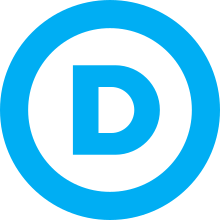
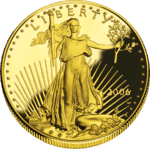
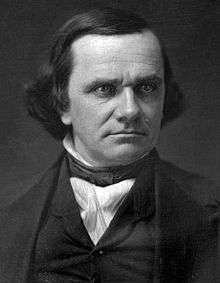

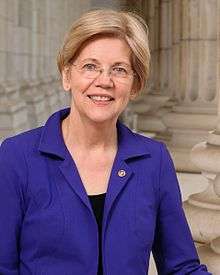
.svg.png)